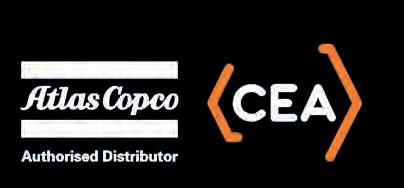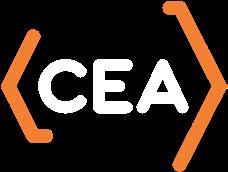FRONT FOOT
Paving in partnership, Wirtgen and ANA Asphalts are both pioneering in the asphalt sector



WELLNESS IN INFRASTRUCTURE
Key industry leaders have formed a new organisation that’s dedicated to creating greater awareness around mental health and wellbeing
A NEW APPROACH
Fulton Hogan’s STEM programs are helping to inspire the nextgeneration of leaders for the infrastructure and utilities sectors
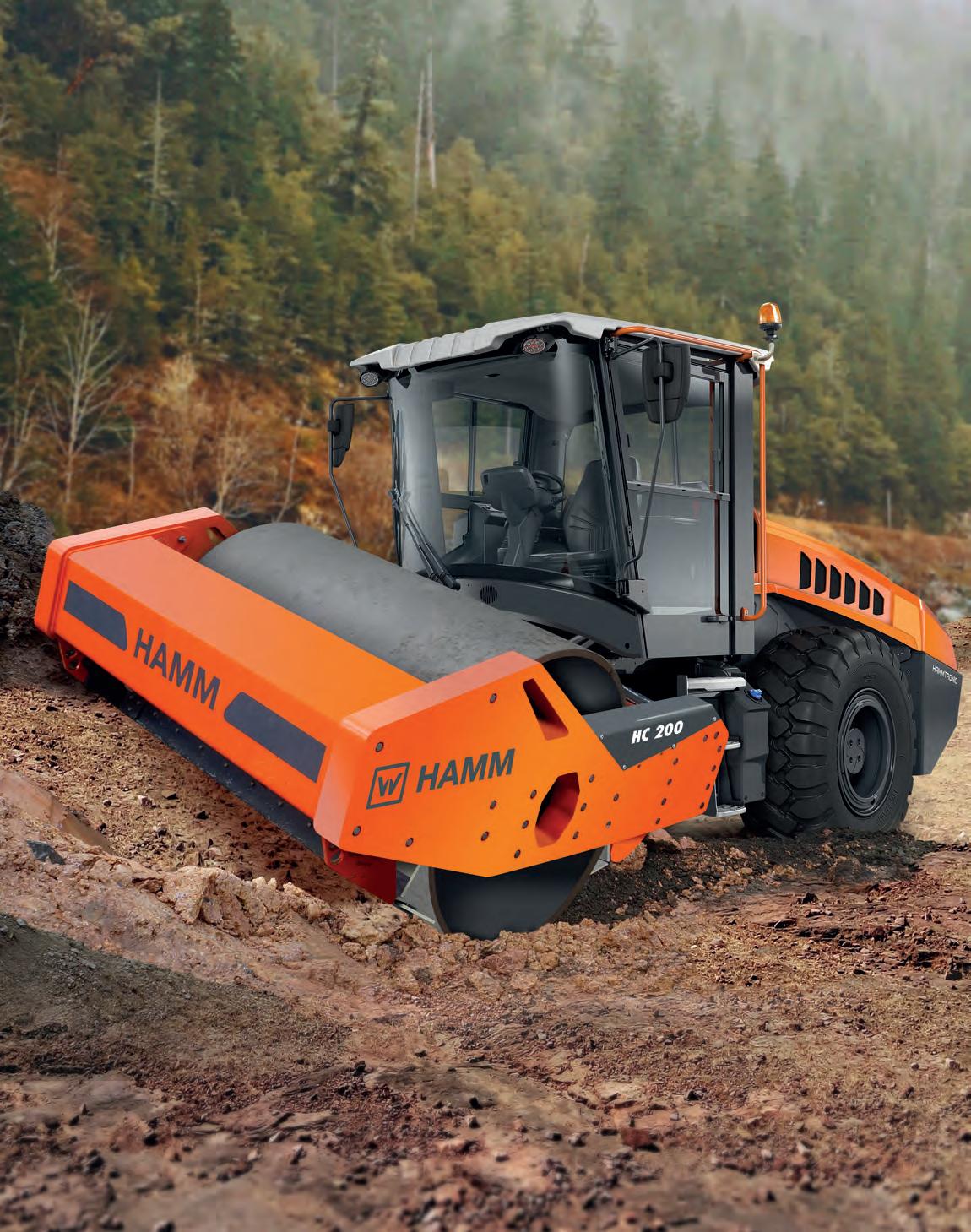
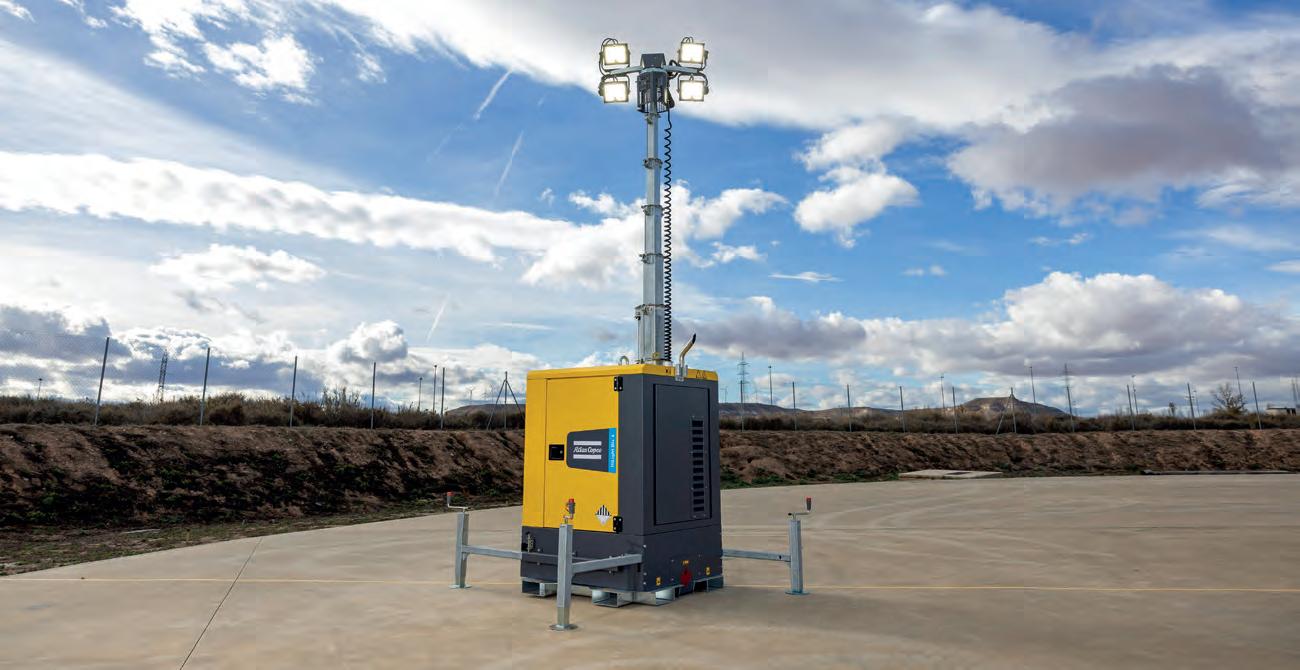


48 Driving increased sustainability
How Komatsu is hoping to exceed expectations when it comes to sustainability.
SAFETY
50 The case for wellness
A new body formed by leading infrastructure providers is helping to create more awareness for mental health.
COVER STORY
15 Always on the front foot
ANA Asphalts has experienced exponential growth since it was founded just a number of years ago, in part thanks to the use of Wirtgen Group machinery.
ROADS REVIEW
18 We ask the sector what needs to change to better cater for the development of sustainable construction materials.
INNOVATION
21 Technical excellence worldwide Colas continues to push the bitumen sector forward thanks to its co-ordinated approach to research and development globally.
25 Creating new pathways
Fulton Hogan’s STEM educational program is enlightening the next-generation of infrastructure leaders.
TECHNOLOGY
29 Solving complexities
Bentley Systems and WSP are working together to smash through potential barriers to resources, data and other complexities.
32 A digitised industry
Road regulatory programs continue to expand across Australia’s transport network. So what’s next?
SUSTAINABILITY
35 What’s the difference?
John Deere’s work in the sustainability space is helping to push construction machinery forward.
MACHINERY & EQUIPMENT
38 Downsizing with purpose
Specialised Roading Equipment has scaled down its iconic telescopic sprayer design to cater for new and existing spraying operators.
41 Hand in hand
Tidd Ross Todd and Kobelco Cranes are working together to deliver high-quality solutions for Australia’s infrastructure sector.
44 Paving ahead
Caterpillar’s relationships with its clients creates a strong partnership to deliver infrastructure excellence.
46 The pick of the bunch Hitachi’s new medium excavator range is the one-stop-shop for modern construction works.
NATIONAL PRECAST SECTION
52 Sustainable silence Sustainable methods are leading to the successful delivery of precast concrete noise walls.
EVENTS
54-57 Know the ins and outs around four highly anticipated and upcoming industry events.
REGULARS
7 News
58 Contracts & Tenders
Below: The development of sustainable infrastructure is put in the spotlight in this edition of Roads & Infrastructure Magazine.
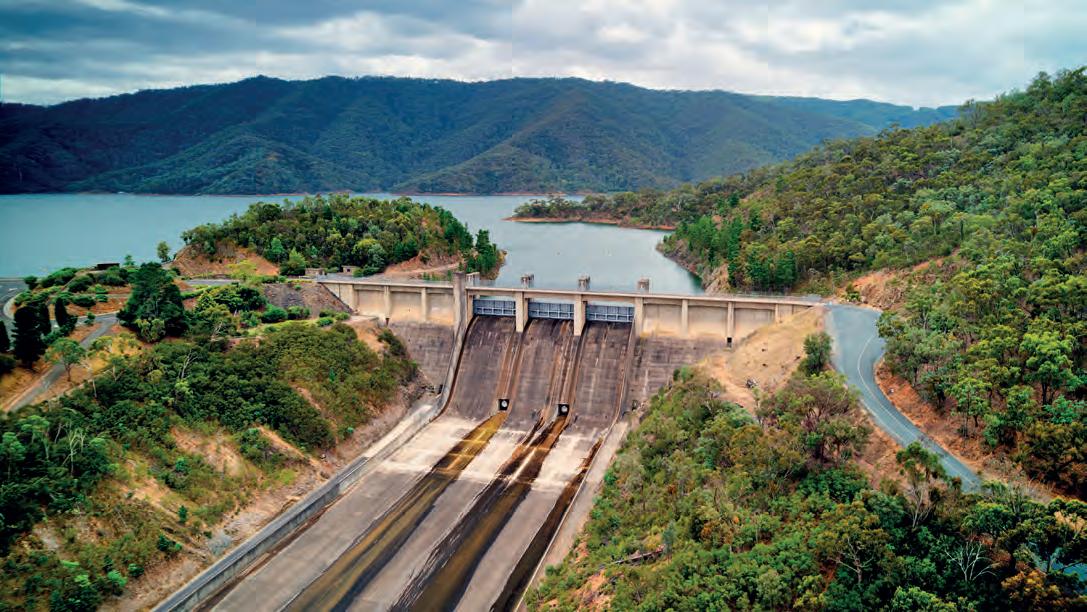

TURNING WORDS INTO ACTION
ACCORDING TO THE NATIONAL OCEANIC and Atmospheric Administration, April this year was the hottest on record, with expectations that 2024 will be the warmest year on record.
Unfortunately our sector is among the biggest contributors of greenhouse gas emissions annually, as such we have a responsibility to reduce our impact in every way that we can.
To help drive further innovation in the sustainability space, we at Roads & Infrastructure Magazine have earmarked the July edition to focus on solutions that are helping to reduce our environmental impact.
We give key industry leaders the microphone to share what they believe will help to spur the development and application of sustainable materials and we ask: what needs to change to better cater for the growth and development of sustainable construction materials?
Roads & Infrastructure Magazine also learns more about Wellness in Infrastructure, a new organisation that’s been formed by some of the sector’s biggest players to improve awareness and normalisation around mental health discussions. Based off revolutionary research, new programs are helping to support employees in an industry that admittedly could be doing more in the mental health space. There’s a lot of room for improvement, but progress such as this is helping to turn the tide.
As part of our cover story coverage, we highlight the growing relationship between machinery manufacturer Wirtgen Group and local New South Wales bitumen works provider ANA Asphalts. We speak with the Director and Co-Founder of ANA Asphalts to learn how, in such a short space of time, the company has elevated itself among the preferred providers in the region. The growth of its machinery fleet has played a key role in this growth.
Another story of interest is Fulton Hogan’s successful implementation of STEM programs for both primary and secondary schools. These programs are helping to develop a new approach to education and learning, by providing students with a problem-based learning scheme that enables them to apply their own knowledge, skills and interests. The program has been expanded across multiple states due to its success, and looks set to grow even further. We talk with the organisation’s leaders in this space to learn what these programs consist of, as well as what their biggest learnings have been so far.
The global expansion of SAMI Bitumen Technologies isn’t slowing down, with the company strengthening its foothold across Australasia. We speak to international leaders from Europe and Asia about the company’s growth in the past few years, the innovations that are now used as standard in many applications and what’s in store for the future. If you want to know what’s on the horizon for the asphalt and bitumen sector, then this is the article for you.
Happy reading!
Tom O’Keane Roads & Infrastructure Magazine
COO
Christine Clancy
christine.clancy@primecreative.com.au
PUBLISHER
Sarah Baker sarah.baker@primecreative.com.au
MANAGING EDITOR
Lisa Korycki lisa.korycki@primecreative.com.au
EDITOR
Tom O’Keane tom.okeane@primecreative.com.au
JOURNALIST
Chris Edwards chris.edwards@primecreative.com.au
DESIGN PRODUCTION MANAGER
Michelle Weston michelle.weston@primecreative.com.au
ART DIRECTOR Blake Storey
DESIGN Bea Barthelson
BUSINESS DEVELOPMENT MANAGER
Brad Marshall brad.marshall@primecreative.com.au
CLIENT SUCCESS MANAGER Salma Kennedy salma.kennedy@primecreative.com.au
HEAD OFFICE
Prime Creative Pty Ltd
379 Docklands Drive, Docklands VIC 3008 Australia p: +61 3 9690 8766 enquiries@primecreative.com.au www.roadsonline.com.au
SUBSCRIPTIONS +61 3 9690 8766 subscriptions@primecreative.com.au
Roads & Infrastructure Australia is available by subscription from the publisher. The rights of refusal are reserved by the publisher.
ARTICLES
All articles submitted for publication become the property of the publisher. The Editor reserves the right to adjust any article to conform with the magazine format.
COVER IMAGE ANA Asphalts
COPYRIGHT
Roads & Infrastructure Australia is owned and published by Prime Creative Media. All material in Roads & Infrastructure Australia is copyright and no part may be reproduced or copied in any form or by any means (graphic, electronic or mechanical including information and retrieval systems) without the written permission of the publisher. The Editor welcomes contributions but reserves the right to accept or reject any material. While every effort has been made to ensure the accuracy of information, Prime Creative Media will not accept responsibility for errors or omissions or for any consequences arising from reliance on information published. The opinions expressed in Roads & Infrastructure Australia are not necessarily the opinions of, or endorsed by the publisher unless otherwise stated.

It takes a different kind of brain behind the brawn. Fired up like a turbo diesel. Gears constantly churning. Hardwired beneath hard hats to solve problems, or avoid them altogether. With you and your crew at the helm, and Deere at your back. The workarounds, ideas and innovations that move earth, and your business, forward. Because that’s what it takes to win in the dirt. And that’s what it means to be Never Idle.


The 4.9t CK series mini crawlers have high specifications, practical capacities and features designed to be a priority utility crane.
Where working space is restricted, such as road and rail tunneling, underground infrastructure, trenches for utilities, foundation work or work on elevated bridges and rail tracks, these high-performance mini crawlers can be relied upon to get the job done.
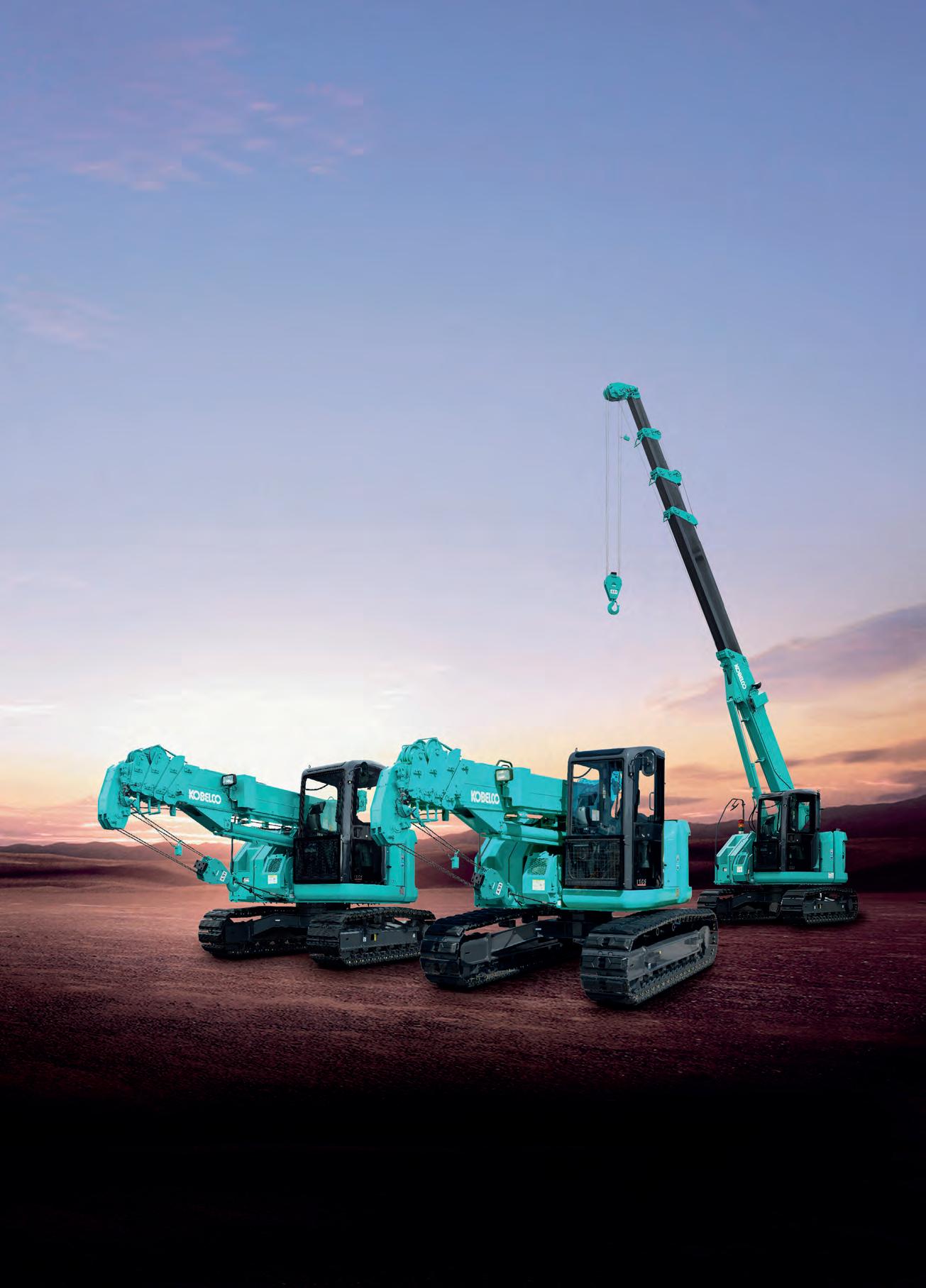
TRT are the Asia-Pacific agents for Kobelco providing a full comprehensive end to end solution. Service and parts support 24/7, 365 days a year during the entire life of your crane.
Troy Hand 1800 595 576
sales@trtaust.com.au
www.trtaustralia.com.au


INFRASTRUCTURE INVESTMENT MAJOR FOCUS OF FEDERAL BUDGET

The Federal Government has handed down its 2024-25 budget, which specifically outlines investment spend towards Australia’s $120 billion, ten-year infrastructure pipeline. Here’s the full rundown.
Better transport for cities, regions and suburbs is a big focus of the Federal Government’s 2024-25 budget, with $9.5 billion announced over the forward estimates, and $16.5 billion over 10 years, for projects that improve productivity, liveability, and sustainability.
$4.1 billion has been allocated to 65 new priority infrastructure projects across Australia.
Queensland leads the way, with $21.6 billion committed over ten years, followed by New South Wales ($20.8 billion), Victoria ($19.2 billion), South Australia ($9.7 billion), Western Australia ($8.9 billion), the Northern Territory ($2.8 billion), Tasmania ($2.2 billion) and the ACT ($808.6 million).
When it comes to specific infrastructure works, funding highlights include $3.3 billion for the North East Link, $1.7 billion for METRONET, $1.2 billion for the Direct Sunshine Coast Rail Line, $500 million to upgrade Mamre Road in Western Sydney, $467.2 million for the Bruce Highway Corridor, $437.3 million for road upgrades in south eastern and northern Melbourne and $400 million to upgrade sections of Elizabeth Drive in New South Wales. Additional highlights include $237.6 million to deliver priority projects along the Stuart, Victoria and Barkley Corridor, $176 million for three new projects along the Regional Roads Corridor and $132.8 million for the Great Northern Highway Corridor.
The Federal Government is also investing $2 billion into planning and delivering more efficient regional transport networks that will transform the way communities live and move within Western Sydney.
A $200 million investment was announced for the Safer Local Roads and Infrastructure Program and $100 million over four years for an Active Transport Fund which will support the construction and upgrade of bicycle and walking paths across Australia. The Budget also provides for $176.4 million to deliver new water infrastructure projects. A further $101.9 million has been committed to upgrade regional airports and remote airstrips.
$100M INFRASTRUCTURE BOOST ANNOUNCED FOR QLD COUNCILS
The Queensland Government has announced a pot of $100 million for critical infrastructure, which is set to be shared across 12 municipal areas in southeast Queensland.
The funding forms part of the South East Queensland Community Stimulus Program, which aims to fast-track investment in critical infrastructure and community assets, such as water supply and maintenance, roads and drainage, disaster resilience projects, community buildings and works to prepare sites for future housing development.
The 2024–27 South East Queensland Community Stimulus Program (SEQCSP) is a three year, $100 million funding program supporting the 12 selected councils. This particular round has a specific focus on projects that deliver critical infrastructure needs and support longterm sustainability.
These include Brisbane City Council,

Gold Coast City Council, Ipswich City Council, Lockyer Valley Regional Council, Logan City Council, Moreton Bay Regional Council, Noosa Shire Council, Redland City Council, Scenic Rim Regional Council, Somerset Regional Council, Sunshine
Coast Regional Council and Toowoomba Regional Council.
Councils can use their allocation towards multiple projects or for a single project up to the total amount of their approved allocation.

FIRST SYDNEY METRO CITY STATION NOW COMPLETE
Waterloo Station has become the first station to be completed on the new city section of the Sydney Metro City & Southwest project.
Following more than four years of major construction, the works to transform the 25-metre-deep station box into a brand new station are complete.
The station will now be handed over to Metro Trains Sydney (MTS), which will
operate the network. Final preparations will also get underway, with MTS set to undertake testing and commissioning before the station fully opens.
The underground Waterloo Station is the first of six new stations that will be delivered in the city section. When it’s open, the new station is expected to have 18,800 passengers pass through daily.
Works will continue on the other Sydney
The new metro station at Waterloo will revitalise the Waterloo precinct, and support the extension of the CBD. Image: Sydney Metro/New South Wales Government.

Metro stations, which will be completed and opened progressively.
It took more than 5000 people a total of five million work hours to complete the new station.
Komatsu Excavators Redefine Power and Precision!

Scan the QR code to learn more.

Elevate your worksite efficiency with Komatsu Excavators. Engineered for strength and precision, these machines redefine durability in every dig, conquering any terrain effortlessly.
Call us today on 1300 074 249 to find out more.
ALBANY RING ROAD NOW OPEN
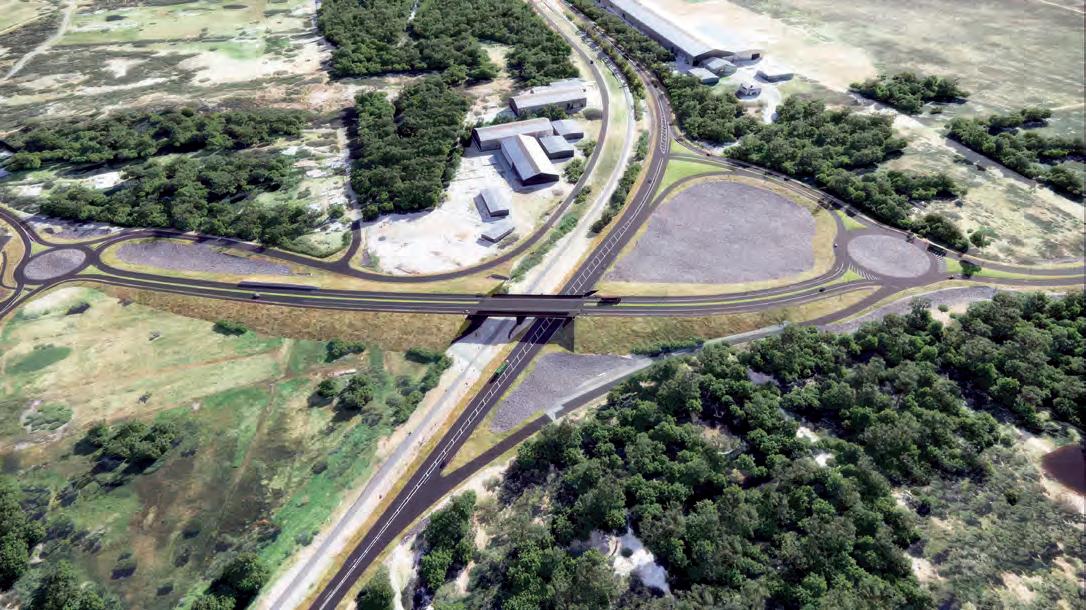
Albany Ring Road, the largest road infrastructure project ever undertaken in the Great Southern region of Western Australia, is now officially open.
The project has delivered a free-flowing, 11-kilometre connection between the original section of Menang Drive east of Albany Highway and Princess Royal Drive, including three grade-separated interchanges at Albany Highway, South
Coast Highway and Hanrahan Road.
The new road will divert heavy vehicles around Albany, improving freight efficiency and underpinning the longterm economic viability of Albany Port. It will also improve traffic flow and safety on the existing road network by reducing heavy vehicles on Albany Highway, South Coast Highway and Chester Pass Road.
There are currently hundreds of trucks moving to and from the port each day, which increases significantly during harvest. The new ring road will remove these trucks from the local road network.
Planning for Albany Ring Road began in 1997, which included the construction of Menang Drive and Albany Highway interchange, completed in 2007.
CONCEPT DESIGNS UNVEILED FOR MELTON LXRPS
The Victorian Government has released concept designs for two level crossing removals at Melton, in Melbourne’s west with the works set to make the region boom gate free by 2026.
All up, these works will deliver level crossing removals for four crossings (at Coburns Road, Exford Road, Ferris Road and Hopkins Road), which is expected to ease congestion for 73,000 vehicles daily.
A new Melton Station will also be delivered as part of this project, with the new station set to open in 2026.
New road bridges will be built over the rail line at Ferris Road (Melton) and Hopkins Road (Truganina). The early concept designs detail the new rail bridges that will take trains over Coburns and Exford roads in Melton and to the new Melton Station.
The Melton level crossing removals will also pave the way for the introduction

of the $650 million Melton Line Upgrade, increasing capacity for passengers by 50 per cent.
Major construction is set to begin later this year.
As a result of feedback, new walking bridges. This aspect has been funded through the Growth Areas Infrastructure Contribution fund (GAIC).
The Victorian Government is removing 110 level crossings from around Melbourne by 2030, with 77 already gone.
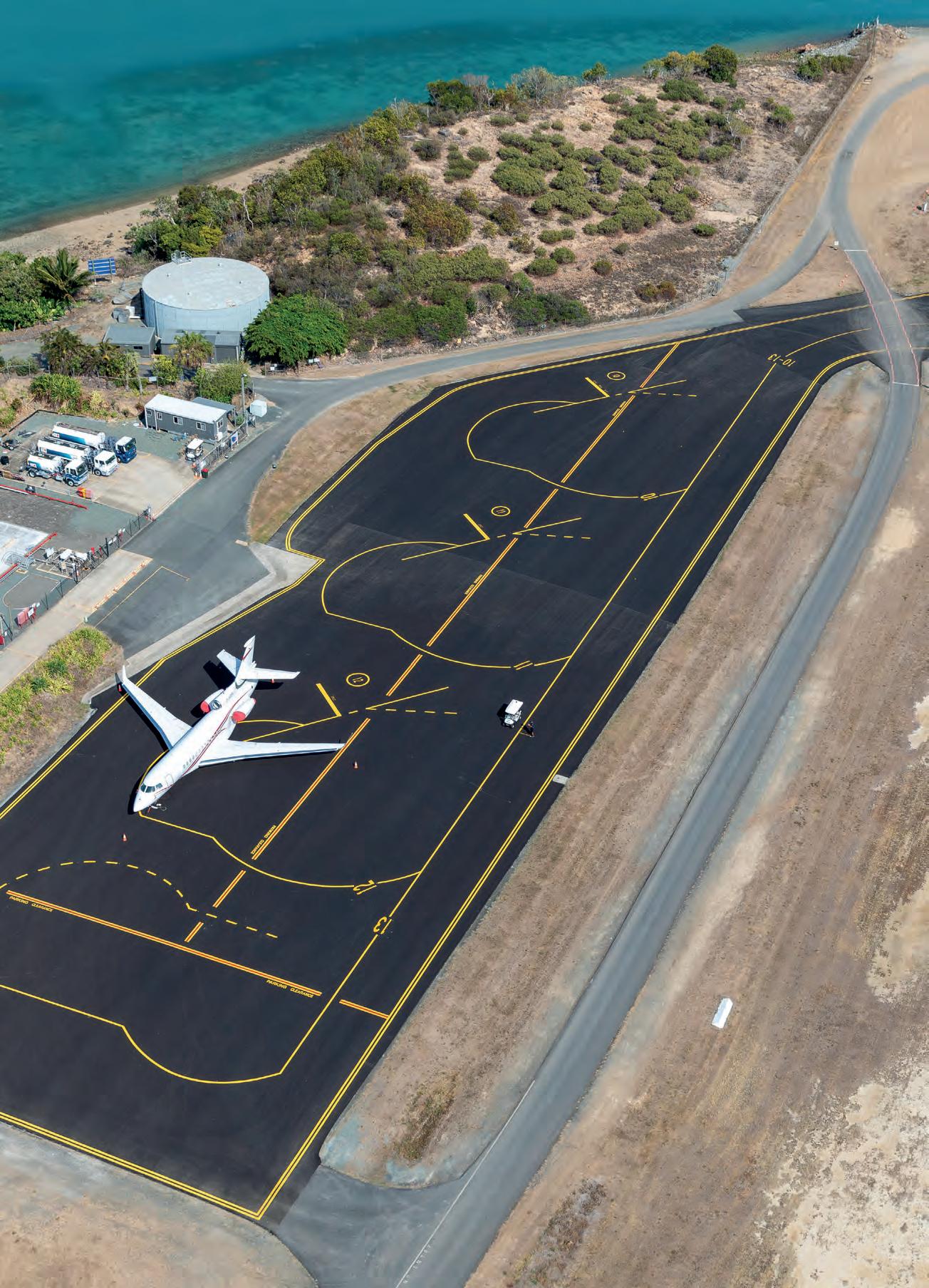

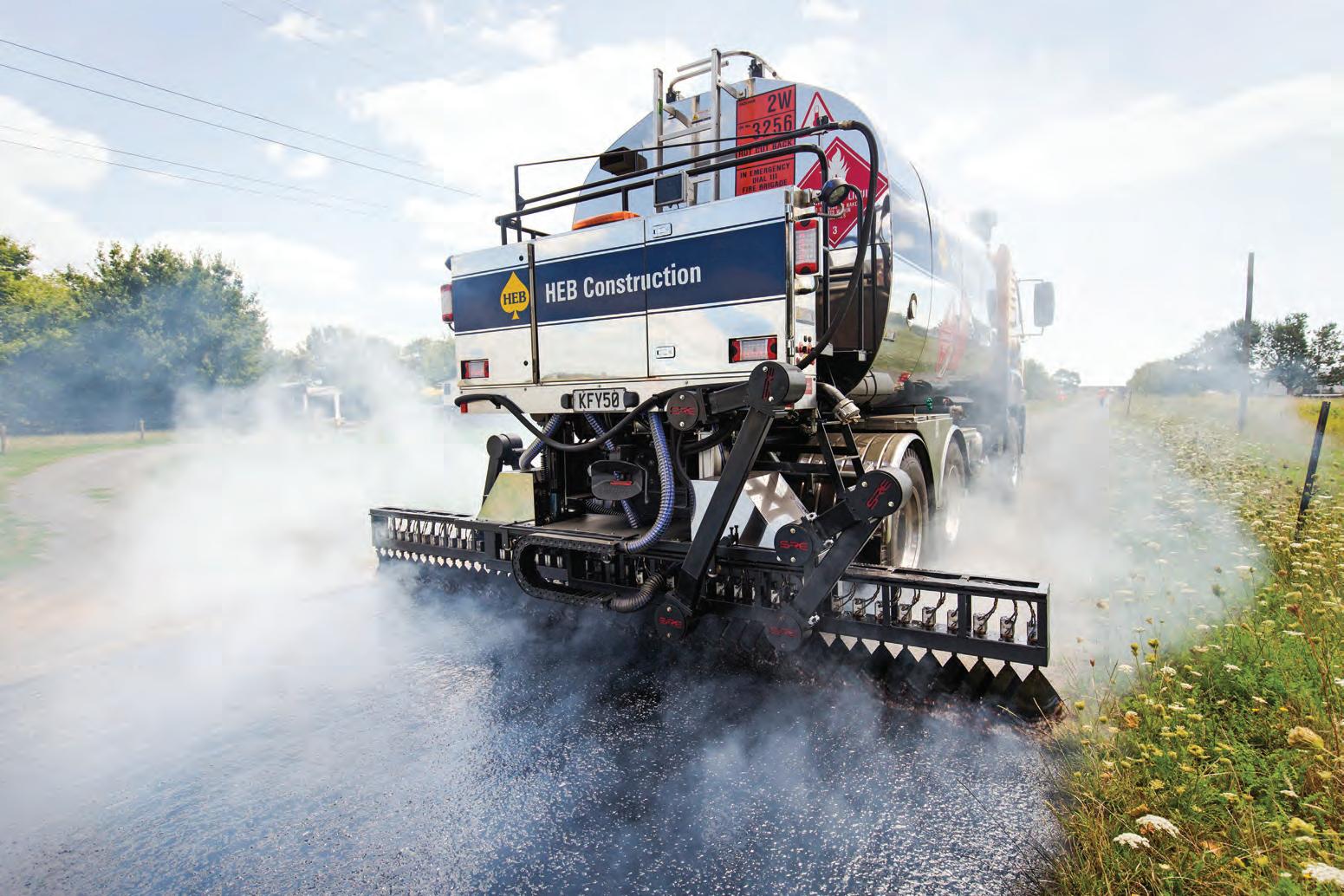
PICK THE RIGHT TOOL
Proud Suppliers of Telescopic Bitumen Sprayers to the Australasian Roading Construction market for over 20 years
Over the last 20+ years, we’ve listened to our customers’ feedback and continuously evolved our range of sprayers, meeting the specific and unique demands of the Australasian roading market.
From our highly manoeuvrable 4.5m telescopic urban sprayers right up to our 6.0m reseal sprayers we have the right sprayer for the job – all offering the ease of use and efficiency of our telescopic spray bar.
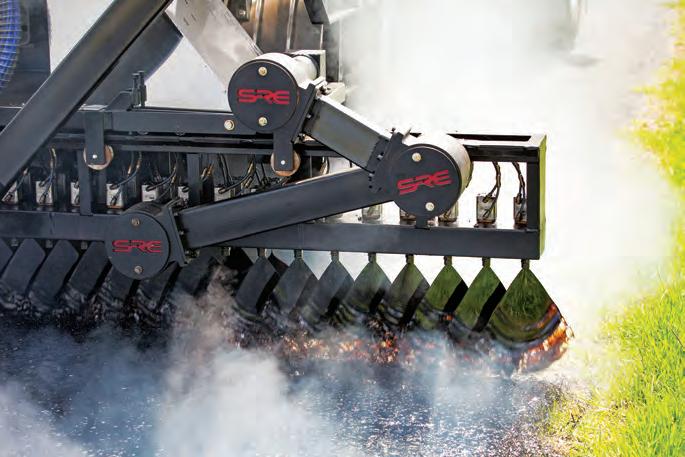
Find out today why operators across Australia and New Zealand are ditching fixed wing sprayers and demanding SRE’s range of telescopic bitumen sprayers.
www.specialisedroadingequipment.com
Email info@specialisedroadingequipment.com
Ph +64 7 848 1197


VIC BUDGET BREAKDOWN: WHAT’S IN STORE FOR INFRASTRUCTURE
The Victorian Government has handed down its 202425 budget, which includes $4.9 billion in additional funding to existing public infrastructure and provides a big boost for the state’s ‘Big Build’, with a focus on metropolitan infrastructure projects.
$752 million has been outlined for the Big Build to expand the network and support the delivery of new stations.
Highlights include $214 million to maintain Digital Train Radio Systems and plan for future upgrades. $104 million will help works to keep rail freight moving across Victoria, including encouraging operators to take up rail, reducing trucks on local roads.
$30 million will go towards better bus travel and continuation of ferry services. This includes works to improve connections to new bus interchanges being built at Croydon, Pakenham and Greensborough stations.
$21 million has been announced for public and active transport upgrades, including construction of shared bike and pedestrian paths in Altona, Epping and South Morang and safety and accessibility upgrades at Essendon train station.
REGIONAL
About $113 million has been committed to support the state’s regional rail network. This will include funds to support the delivery of new train stabling yards, as well as stations alongside the new locally built VLocity trains. $60.5 million will go to regional road upgrades over the next four years, with road and bridge projects, including works on the Western Highway.
These funds will also go to upgrading the 150-year-old historic rail tunnel between Geelong and South Geelong.
$62 million will go to upgrades to make regional roads safer and improve freight routes, including upgrading
the Princes Highway East, upgrading the Sale Alternative Truck Route in Gippsland, upgrading the Dimboola Bridge, creating a pedestrian crossing on the Calder Highway at Wedderburn and more.
To further improve road safety, the Budget provides $5.2 million for a closed-circuit track trial to study the effects of medicinal cannabis on driver impairment.
It’s also important to note that there have been criticisms and hopes that such funding would be diverted away from major works such as the Suburban Rail Loop and spread to the regions, both from government and local authorities.
The State Government has also acknowledged upcoming challenges for the infrastructure sector. Increases to the cost of materials, labour and transportation have pushed up the cost of construction in Victoria by about 22 per cent since 2021 (per Victorian Government).
INDUSTRY REACTION
Infrastructure Partnerships Australia has labelled the budget as a “sobering infrastructure spend”.
“While Treasurer (Tim) Pallas is seeking
to flatten the curve on state debt, the short-term impact is an almost complete absence of notable new capital projects,” a spokesperson said. “Treasurer Pallas has commendably made the tough, albeit necessary decisions to deliver a smoother, and more sustainable infrastructure pipeline.
“Near term, that is inevitable and necessary – but it mustn’t become permanent. Population growth is not going away, so pulling stumps on capacity in the medium and longer term is simply not an option.”
Civil Contractors Federation Victoria highlighted the new investments in the coming year, including $4.9 billion in additional funding to existing public infrastructure.
“One positive for civil contractors –who continue to battle ongoing market issues and capacity constraints – was that no new taxes or levies were announced in this Budget, compared to last year,” they said.
“While pitched as family-friendly, supposedly to address cost-of-living pressures, the reality is that this year’s Budget does not have any new major infrastructure initiatives, but rather is a continuation of existing projects from last year and the past decade.”


Reduce the Risk of Managing your Sites
Technology in site and asset management is transforming the way teams work by bringing real-time visibility and analytics across projects. Telematics is designed to enhance operator safety, increase utilisation, improve on maintenance, reduce fuel costs, and improve FTC rebates.




ALWAYS ON THE
FRONT FOOT
KEEPING AHEAD OF INDUSTRY REQUIREMENTS HAS LED TO THE EXPONENTIAL GROWTH OF ANA ASPHALTS SINCE 2014. WIRTGEN MACHINERY HAS ALSO PLAYED A ROLE, AS DIRECTOR ANGUS WALKER EXPLAINS.
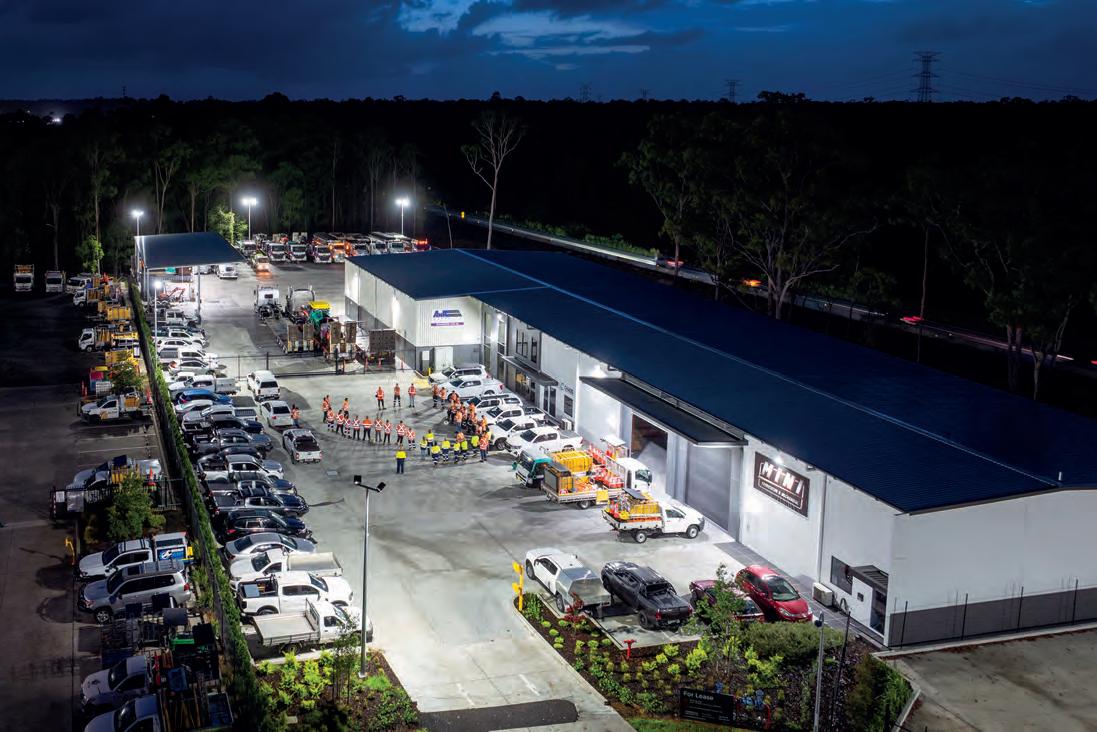
Wcontractors or private customers, ANA Asphalts has gone from the ‘new kid on the block’ to catering for some of the largest and toughest infrastructure projects in New South Wales. Operating throughout Newcastle, the company is the by-product of company Director Angus Walker’s experience in the asphalt sector, as well as his enthusiasm to forge his own path.
Initially starting his journey alongside his father laying asphalt, Walker co-founded ANA Asphalts to provide a local-first service that’s focused on providing the highest quality. As he explains, the company represents a mix between the service and thoughtfulness of a local business with the quality and scope of a larger provider.
a big vision,” he says. “My business partner at the time and I bought our own bobcat, a small paver and a roller and it all started from there. I just continued to grow the business anyway that I could.”
From these humble beginnings, Walker’s drive and passion, as well as his industry connections, have helped to fuel ANA Asphalts’ success.
Presentation, housekeeping, safety, production and customer satisfaction have long been front and centre for ANA Asphalts. As such, the company places no priority higher than delivering on the customer’s needs.
START OF SOMETHING SPECIAL
Now with decades worth of experience and
Asphalts still remains an Australian and familyowned business, with Walker’s ascendence playing a big part in ANA Asphalts’ completing works for tier one infrastructure companies.
So has the use of the latest machinery and equipment.
“I was doing some contracting work for Colas when I laid my eyes on one of the Wirtgen Group’s Vögele pavers,” says Walker.
“The presentation was one of the biggest things that stuck out to me. Shortly after I reached out to Wirtgen. They had a cancelled order, so we received our first within weeks.
“That was our first Vögele paver in 2016. From there our fleet as well as the relationship with Wirtgen has gone from strength to strength.”
“Strength to strength” could be considered
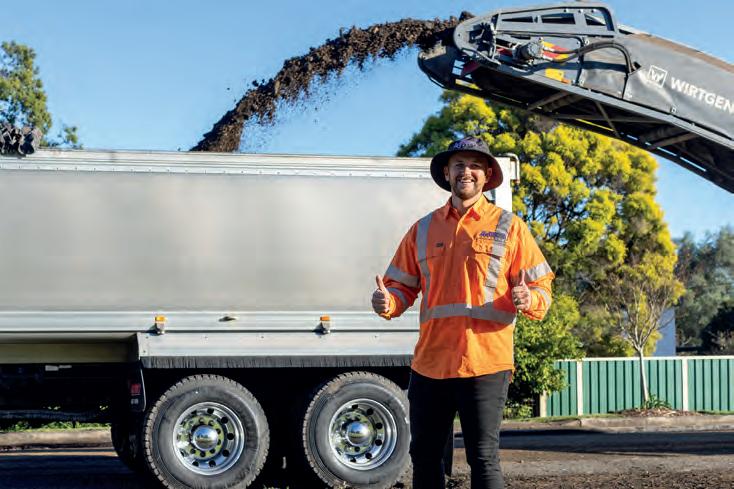
an understatement. ANA Asphalts more than tripled in size in just a matter of years, with Wirtgen machinery playing a pivotal role in this expansion.
In 2019, ANA Asphalts added its second asphalt crew. The year 2020 also represented growth, with the company adding a third crew, as well as hitting the quarter of a century milestone, amassing 25 machines from Wirtgen, including pavers and rollers.
ANA Asphalts then went on to purchase new profilers at the beginning of 2022, 2023 as well as 2024.
“The first paver that we bought from them, we’ve still got, and we still use. It’s already been in use for eight years and clocked up more than 10,000 hours and that machine still goes to work every day,” Walker says.
“They’ve had the best profilers in the market for a long time. It’s the reliability and the support from those guys that’s really stood out. Even through the buyout from John Deere, when there was a risk of distraction and disruption, Wirtgen stayed on course and continued to support us to the highest standard without a blip.”
Using Wirtgen machinery, ANA Asphalts recently completed works on the M1 Pacific Motorway, in particular the section between Tuggerah to Doyalson.
Initially the company started the works with just one asphalt paver. Expectations from the client required Walker and the team to acquire an additional two machines. Wirtgen was right at the top of the call sheet.
“Wirtgen made that happen for us really quickly, as we were expected to pave anywhere between 1000 to 1500 tonnes every day for a few years. That was a really
important project for our growth and the customer was really pleased,” Walker says.
“From a technology standpoint, quality assurance and the way that these machines are built, they make a massive difference to our business. The amount of asphalt that we can get down on the ground and the speed that we can deliver quality from having the right machines for the job at hand – whether its compaction, profiling, paving, they’ve got it all.”
BETTER TOGETHER
Wirtgen’s philosophy is to provide the right machine for every application. When considering pavers alone, the company has options across five different machinery classes. All best suited to specific works, from works on footpaths to major highway projects.

Wirtgen Group Machinery make up almost the entirety of ANA Asphalts’ machinery fleet, with the two companies sharing a strong commitment to quality and safety.
Its Universal Class aims to deliver a versatile and powerful mix, a machine that can handle both highway projects and roundabouts. Each of these units in their own way can also be used in tandem with other Wirtgen Group machinery.
With every noteworthy jump, Wirtgen has been there. A fact that Walker and the ANA Asphalts team don’t take for granted.
“We’ve branched out into spray seal, traffic control and virtually all aspects of road paving

ANA Asphalts’ portfolio

from start to finish. They’ve been there every step of the way. Whenever we’ve had any issues, they’ve been more than willing to assist,” Walker says. “You can tell they care about their customers.”
Wirtgen has even taken Walker and some of the ANA Asphalts team overseas to Germany so they can learn more about Vögele’s development and innovation from its main factory in Ludwigshafen, on the Rhine.

“We did some paver training and technology training to help us to use the machine to its full potential. That experience really opened our eyes to the broader range of products that they supply,” Walker says.
“They really showcased what’s next in terms of sustainability and the future of asphalt paving and road construction. It was great in terms of innovation and networking. We met some really great people and formed some good relationships.”
Following the trip, ANA Asphalts is also beginning to implement recycling into its business.
“That experience really showed how far the envelope is being pushed overseas and how far we’ve got to go in terms of technology and sustainability,” Walker says.
“A big take away for me was the importance of doing more work, with less resources and
input. It was a real inspiration to be smarter in the way that we do things. One thing that we’ve all learnt, especially when it comes to contracts is that it’s better to always be on the front foot.”
Walker says this is a common theme across the entire company, to never settle, to always push to be better.
“We don’t just stop when we’re comfortable, we’re always trying to push the limit and make things better,” he says. “Just because we’ve had a great day today, doesn’t mean that we can’t have an even better day tomorrow – that’s the attitude that we’ve always got.
“The driving force behind that is the people that we have in the business. We all lead by example; I’d like to think that my qualities and attributes have been pushed down to the crews.
“No has never been in our vocabulary. Even adopting spray sealing has been a challenge, but we know in the long run that it will enable us to better service the needs of our customers.”
FUTURE FOCUS
Walker and the senior management team always have one eye locked on the future, evaluating future works contracts and
needs of the business. Despite ambition toward further growth and larger works, Walker remains grounded in the sector and community that first gave him his shot. That’s why the focus on local employees and materials will never peter out.
“Around 95 per cent of our total workforce is from the Newcastle area. Our mechanics, materials and parts suppliers – they’re all based local and that’s the way that we try to keep it,” he says.
When it comes to what’s in store for the future of ANA Asphalts, Walker says among the company’s objectives is to eventually veer towards asphalt manufacturing. A venture that he admits may be some time away, but yet another challenge that the team is keen to embrace.
“I’d like to think that we’ve mastered many different disciplines and areas when it comes to asphalt, but there’s still more to do,” he says. “We really want and need to adapt to what the market needs.
“It’s about that attention to detail, that’s what the market is paying us for. We do what we say and say what we do. That’s another reason why we are branching out, we’ll do everything from start to finish. Whatever the task is ahead of us, we’ll find a way to get it done.”
ROADS REVIEW
THIS MONTH, WE ASKED THE INDUSTRY’S DECISION-MAKERS, ‘WHAT NEEDS TO CHANGE TO BETTER CATER FOR THE GROWTH AND DEVELOPMENT OF SUSTAINABLE CONSTRUCTION MATERIALS?’

SARAH BACHMANN, CEO – NATIONAL PRECAST
Both policy and resources are critical factors in the sustainable development of infrastructure, but policy is the driver and often poses the greater challenge. Effective policy can drive the adoption of sustainable practices and innovative construction methods, setting the framework within which resources are allocated and utilised. Policy, encouragement and incentivisation of sustainable products and construction methods like offsite-manufactured precast, maximises productivity with fast construction and safer sites due to work being done in factories. Efficient use of resources minimises waste, and mixes can incorporate waste materials. Durability is guaranteed and ongoing maintenance requirements are minimal.
Image: National Precast.



EHSSAN VEISZADEH, CEO – ROADS AUSTRALIA
The infrastructure sector is ready to decarbonise, but industry want to be clear on government requirements, so they know where to invest their resources best to meet the goal of net zero. We heard at the recent Roads Australia Decarbonisation Roundtable that carbon consideration should be a visible and weighted part of procurement to drive sector-wide change. The roundtable also heard that to support decarbonisation, greater flexibility is needed postbusiness case to enable contracting partners to bring innovation to market. With the right policy settings in place, the calls on trade-offs to decarbonise can be better understood and shared to accelerate delivery on Australia’s 2050 targets.
Image: Roads Australia.
TONY ALOISIO, INTERIM CHIEF EXECUTIVE OFFICER – AUSTRALIAN FLEXIBLE PAVEMENT ASSOCIATION
We need to develop and grow a sustainable infrastructure ecosystem that values positive environmental outcomes – some might call it a Circular Economy. Traditional market-based economies cannot achieve this without the right policy levers in place. The delivery of road infrastructure projects and maintenance activities requires government investment with policies that drive reduced embodied carbon and increased circularity of materials, together with a regulatory framework that facilitates the supply of critical materials and skills. Sustainable infrastructure development must start with policy being turned into tangible implementation strategies that support an integrated resources pipeline.
Image: Australian Flexible Pavement Association.
If you or someone at your organisation is an industry leader and would like to be a part of this monthly column in 2024, please get in touch with Editor, Tom O’Keane: tom.okeane@primecreative.com.au
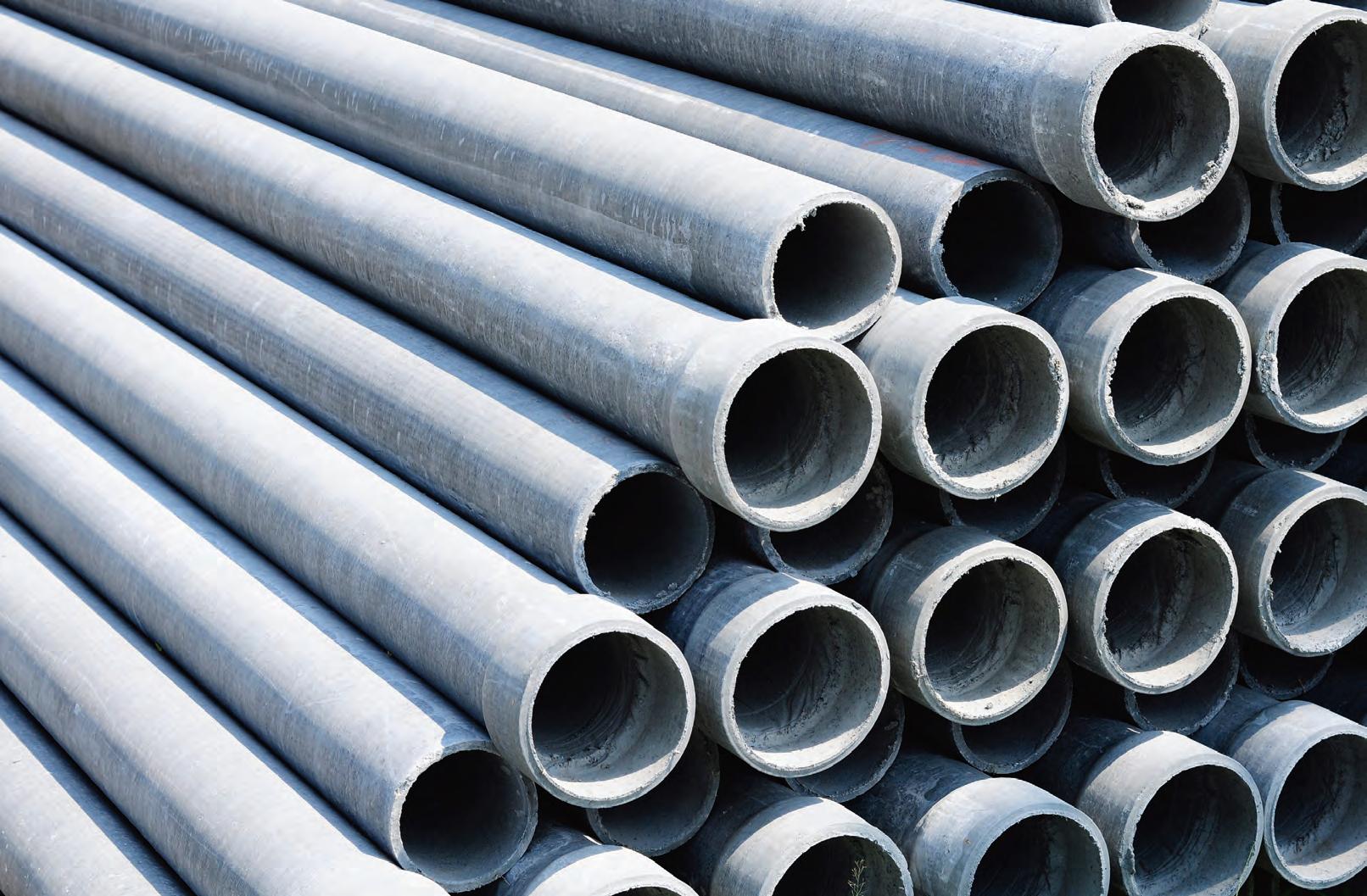


MURRAY BUTTERWORTH, GENERAL MANAGER RECYCLING – ALEX FRASER
Policy and resources both pose significant challenges to sustainable infrastructure development. While resources can be managed with technological advancements and efficient practices, policy involves navigating complex regulatory landscapes and achieving consensus among varied stakeholders. Policies shape the framework within which resources are utilised, and their impact is far-reaching. The establishment of supportive policies is crucial for sustainable infrastructure development, like the introduction of the Victorian Government’s Recycled First Policy in 2020. This set out to transform the procurement practices on major projects to accelerate the circular economy, reduce the environmental impact of infrastructure and increase the use of recycled materials while maintaining specification.
Image: Alex Fraser.

HAMIDREZA SAHEBZAMANI, TECHNICAL SERVICES MANAGER – SAMI BITUMEN TECHNOLOGIES
Both policy and resources play significant roles in the challenges faced in sustainable infrastructure development. The greatest challenge to sustainable infrastructure development can vary depending on the context and specific circumstances. Policy challenges can include a lack of clear regulatory frameworks, inadequate legislation, limited political will, and inefficient decision-making processes. These can create barriers and delays in implementing sustainable infrastructure projects. Resource challenges can include financial limitations, lack of technical expertise, insufficient access to technology and materials, and limited availability of sustainable energy sources. These factors can hinder the development and deployment of sustainable infrastructure solutions.
Image: SAMI Bitumen Technologies.

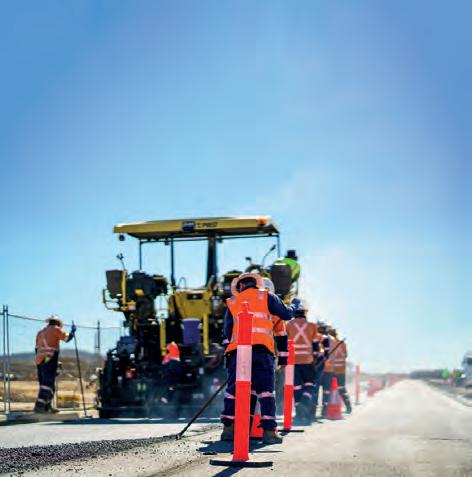
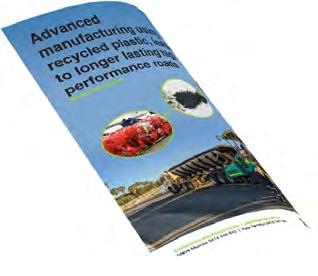

Roads & Infrastructure Australia is a leading news resource for the Australian roads, civil engineering, and infrastructure sectors.
Catering to Australia’s civil and road construction industry, Roads & Infrastructure Australia is a key source for industry decisionmakers, contractors, civil engineers and individuals in local and state government sectors and the private sector looking to keep up to date with important issues, developments, projects and innovations shaping the industry today.
COMPACT SIZE CAN MEAN
A HUGE ADVANTAGE
CAT® AP400 ASPHALT PAVER
The Cat® AP400 is the perfect machine for those asphalt paving jobs where space is at a premium.
It’s got the compact size, flexibility and versatility you need, especially in built-up urban areas.
Plus, when you purchase a new Cat AP400, you’ll also have the option of:
• access to locally supported parts via the national dealer network
• a comprehensive warranty package
• a Cat Customer Value Agreement (CVA).
To find out more contact your local Cat dealer or visit cat.com/AP400-au



WORLDWIDE TECHNICAL EXCELLENCE
AS ONE OF THE WORLD’S LARGEST ROAD CONSTRUCTION COMPANIES, COLAS CONTINUES TO PUSH THE BITUMEN AND ASPHALT SECTOR FORWARD THANKS TO ITS CO-ORDINATED APPROACH TO RESEARCH AND DEVELOPMENT. LEADERS WITHIN THE COMPANY EXPLAIN HOW THIS APPROACH CONTRIBUTES TO SUCCESS.
With 58,000 employees working across 50 countries, Colas has established itself as a global powerhouse for road construction materials supply.
Its quality machinery, advanced testing equipment and the number of technical personnel in laboratories and technical support divisions worldwide has allowed Colas to design many products that are now used as standard practice in every corner of the globe.
For someone like Xavier Guyot, Technical Director – Colas Asia Pacific, this presents ample opportunity to work in multiple sites across the world. Throughout his 25 years at Colas, Guyot has led laboratories in locations such as Madagascar, Reunion Island, South Africa and Bangkok.
“I started as a Technical Engineer in France in our quality control laboratory,” he says.
“The move to Madagascar saw me leading the main laboratory there, supporting product development and operations on big projects. It was a really busy period for all of us.”
Guyot has spearheaded the growth of the local bitumen sector across each of these regions and he’s a respected figurehead for the company’s Asia Pacific division.
He believes Colas’ global capability is what separates the company from other providers in the market.
“We are present in 50 countries across Europe, the United States, Canada, Africa, the Middle East, Southeast Asia and the Pacific. These sites are all connected through our technical networking sites, and we have a central laboratory focused on research
and development called the ‘Core Centre’,” he says.
The Core Centre, located in Paris, is the world’s largest private road and pavement laboratory and acts as a central hub for Colas’ technical expertise, heading up development on new products for international use.
Once designed, tested and approved, these products are distributed across Colas’ many subsidiaries.
In Australia, products are distributed through Colas Australia, as well as SAMI Bitumen Technologies, with the Australian supply chain supported by Colas’ international bitumen stream.
Cédric Leroux, the Director of the Core Centre, says the centre has extensive testing facilities and its teams have technical expertise in a range of fields, such as
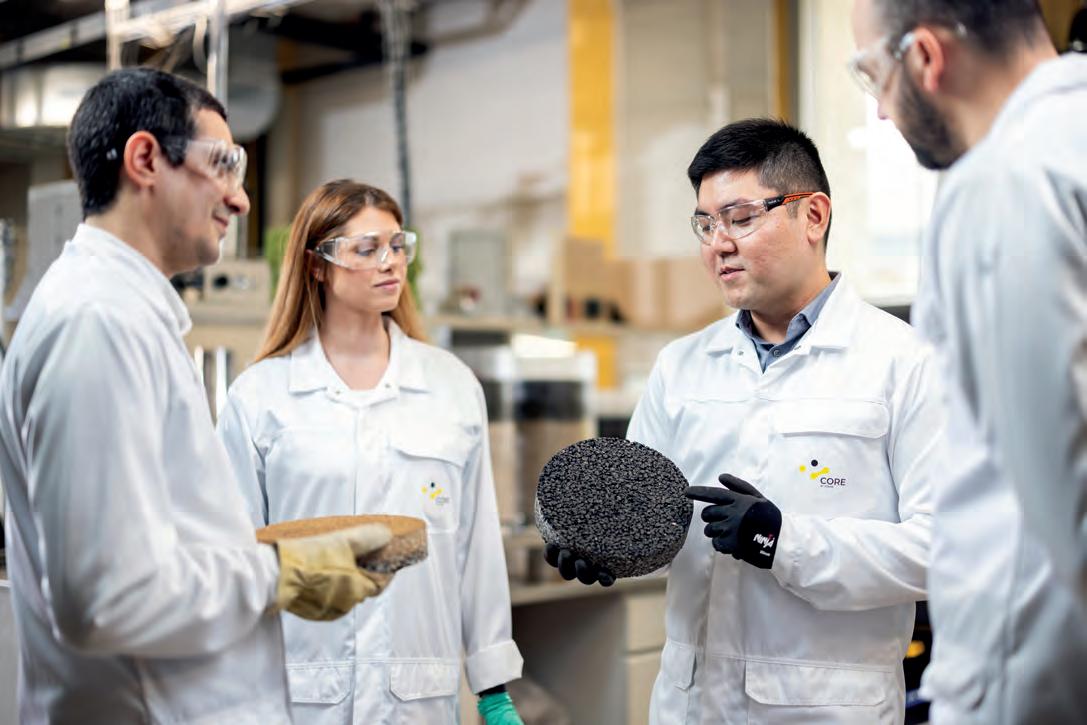

bituminous mixes, concretes, materials treated with hydraulic binders, bitumen emulsions, resins, road paints, geotechnics and more.
“My work puts me in contact with many people within the group, from different countries and cultures, and enables me to talk to them to understand their needs and see how we at the Core Centre can support them in their projects to develop new solutions,” Leroux says.
“The wide range of subjects covered through these exchanges enables us to continue to develop our knowledge, encourages us to develop our technical skills in certain areas or to acquire new ones so that we have the capacity to propose innovative solutions that can be offered to our customers.”
Leroux says the ambition to always be at the forefront of technical developments is still very much alive within the group.
“It is reflected in the provision of significant resources – the Core Centre is a perfect illustration of this – but also in high expectations in terms of the development and deployment of these new solutions in our markets with our customers,” he says.
“It’s not just a question of developing a new product, but also of ensuring that it will be adopted by our customers. Taking on technical challenges is interesting, but it’s only when a new product is developed in a market that we at the Core Centre feel we have really accomplished our mission.”
While Colas’ operations are centred around
“WE’RE ONE OF THE MAJOR MANUFACTURERS AND SUPPLIERS OF BITUMEN, BITUMEN EMULSIONS AND MORE TO THE CANADIAN MARKET.”
the Core Centre and its works in Europe, each region retains its own independence to meet its varying demands.
“There’s a global network but we’re all different in our own ways,” Guyot says. “The way that we correspond in Southeast Asia and Australia is quite specific. There’s a big focus around bitumen binders and emulsionspecific binders.
“There are also specifications that change between nations that need to be met. Development and communication with the Core Centre is more of an exchange as a result.”
This is usually co-ordinated through monthly or quarterly meetings to evaluate and reflect on on-going projects.
As part of its focus on satisfying regional requirements, Colas frequently acquires leading bitumen providers where possible, further adding to the strength of its global portfolio. One such business is McAsphalt Industries, which was acquired in 2018.
Anton Kucharek, Director, Innovation and Product Development – McAsphalt Industries says the Canadian-based company has been empowered by Colas’ rich resources in materials, knowledge and staff.
“We’re one of the major manufacturers and suppliers of bitumen, bitumen emulsion and more to the Canadian market,” he says. “In the
past, as a standalone company, we kept our innovations and discoveries to ourselves. All of a sudden, we were opened up to a global technical network.
“Within the space of months we had highly qualified peers that we could bounce ideas off in Europe, Asia and more. We’re all focused on similar goals and encountering the same problems, so it’s a much more creative environment.”
For Kucharek and his team, having access to state-of-the-art equipment and processes has provided a boost to internal development, helping the company to stay at the forefront of technical innovation for Canada’s bitumen sector.
“We’ve even been surprised by the number of similar entities that border us in the States, who we’re now working really closely with,” he says. “Even the branches in Australia have been a steady partner and presence for that work that we’re doing. It’s truly a global network.”
For McAsphalt, decarbonisation is one of its projects currently receiving significant funding and resources. These efforts have gained momentum, aided by the technical expertise of representatives within Colas. Kucharek says sustainability is a major focus throughout the global network.
“We need to work out how we can best
its vast global

decarbonise as we’re a group that’s working within a sector that has a substantial carbon footprint associated with it. Along with Colas, we’re looking at developing greener materials and that’s our number one priority right now,” he says.
“This includes a big focus on pushing our cold mix elements further to make our products substantially greener.”
KEEPING IT LOCAL
Guyot says this balance between independency and co-dependency allows the global Colas network to also tackle global objectives more efficiently. For example, if Colas is looking to develop a new emulsion design that reduces the volume of materials needed, while reducing emissions, each location can spearhead its own development to achieve this common goal.
“We’re now discussing and working together on a number of technical topics,” Guyot says. “In places like Canada there are some similarities when it comes to specifications and development with Australia.
“There’s some good discussion and interactions to be had about the use of raw materials. We’re already learning a lot around what other regions are using, what they’re not using and some other helpful feedback.”
If any regions have questions about development direction, or general product inquiries, communication is always open.
“Whether it’s Teams or face-to-face, it’s really easy to share information. We can communicate directly with the Core Centre
from Australia, even if it’s about a product that was developed in France for use in North America,” Guyot says.
“That’s what’s great about our organisation, the sharing of information that’s happening all the time. It’s really valuable for all of us.”
This information exchange, along with the ingenuity of SAMI Bitumen Technologies, has led to the successful development of products such as EME asphalt in Australia.
“It’s one of the best examples of innovation that started in France, before it was successfully implemented in South Africa and then finally Australia. How we developed the specification and a best-in-class product for Australia has been one of the standout achievements since I’ve been operating in the region,” Guyot says. “It’s not easy to develop a new product in Australia that’s come from abroad.
“Another standout has been our emulsion-based products, which we started development on almost 40 years ago in Southeast Asia. It was a great example where we successfully applied our technical knowledge, formulation, chemical process, equipment and manufacturing approach.”
Guyot says one of the biggest challenges during his career has been adjusting and meeting different specifications across regions. An undertaking that he says also presents exciting opportunities to push Colas’ products and innovation further.
“It’s not only local specifications, but also local practices and habits that you have to cater for,” he says. “We design and manage the same products worldwide, but the way that it’s sold and applied can be completely different.
“The exact same product can be classified noticeably different. That’s why it’s important to support the operation of separate regions. It’s just not possible to market and apply a single product consistently across the globe. You need to test, adapt and customise accordingly.”

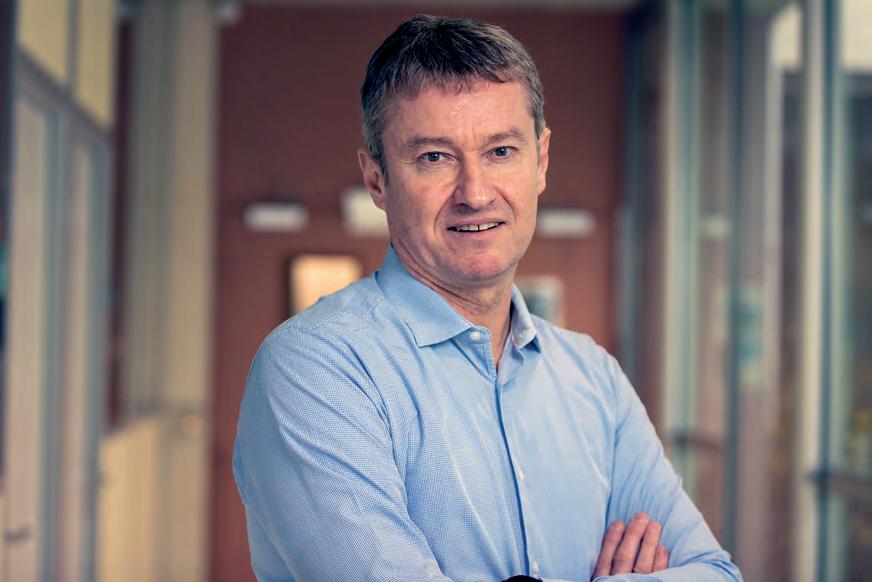
Colas’ global network is designed to adapt to on-going industry challenges. The current sparse supply of materials and skilled workers is just one example. Guyot says Australia is “pushing hard” to combat these barriers to productivity, with solutions hopefully on the way soon.
“Australia can be seen as being right up there when it comes to product development. We’re pushing in the right direction when it comes to reducing waste and emissions in the final product. Australia is a country that’s willing to try and develop

cope with these changes. This will help us to adjust and mitigate these impacts for the market.”
Decode the Transportation Infrastructure Lifecycle Story
As we grapple with aging infrastructure, burgeoning populations, and increased demand, it’s imperative to adopt agile, innovative strategies. Navigate the Bentley Transportation Lifecycle Webinar series alongside industry experts to:
� Make informed decisions to deliver superior outcomes, transforming asset design, construction, and operation for sustainability and resilience.
� Unlock insights throughout the project lifecycle to create sustainable transportation networks.
� Leverage data from IoT sensors and drones to create digital twins for improved decision-making.
� Reduce design time by at least 20% without adding extra staff.
� Enhance data handover from design to construction, optimizing workflows and efficiency by aligning subsurface and engineering data across project phases.
To register, scan the QR code below.


CREATING NEW PATHWAYS
FULTON HOGAN’S STEM EDUCATIONAL PROGRAM IS ENLIGHTENING THE NEXT GENERATION, ENCOURAGING THEM TO MAKE THE MOST OF WHAT THE INFRASTRUCTURE AND UTILITY SECTORS HAVE TO OFFER.
STEM, or Science, Technology, Engineering and Mathematics, is a key group of distinct but related disciplines that feature heavily in the basic school curriculum.
While these subjects may not evoke enthusiastic engagement from some young students, they’re the cornerstones for the development of skills that make up essential roles in the infrastructure sector, such as engineers, designers, architects, surveyors and more.
Dave Evans, Pre Contracts Manager –Utilities at Fulton Hogan, is known as the main driver behind the creation of Fulton Hogan’s STEM program. As he explains, a casual conversation with his wife Christie laid the breadcrumbs for what would become a national program.
“It actually started because I was trying to help my wife out. Back in 2015, the Education Department in South Australia introduced STEM problem-based learning as a new way to teach kids,” Evans says. “It was all about giving the students a real-world problem that they could use STEM disciplines to try and solve.
“Christie was told that this learning program would be difficult to apply to primary school, as it was developed for high school learning.”
Christie was given an industry partner who helped to develop a real-life problem. The only issue? The problem didn’t require an engineering perspective.
“She was asking ‘how am I going to develop a real-world problem that incorporates STEM in the solution?’ That’s where I said that Fulton Hogan encounters interesting engineering challenges all the time,” Evans says.
Evans described a works package that Fulton Hogan was tendering for a key water sector client at the time on the
Murray River. These prospective works consisted of environmental, ecological and logistical challenges. Some of these included the need to develop a water regulating structure without interfering with local flora and fauna, which required nonconventional solutions.
“We had environmental restrictions,” Evans says. “We had cultural heritage-related considerations. There was something like 38 native species of grass in the area. These are primary concerns for a project like this – to ensure that we maintain the existing ecological system and are not impacting on local cultural heritage, all while building a significant structure.
“Christie had a big grin on her face, and she asked if we could be her industry partner. I went to work the next day, spoke to our
general manager at the time and we got full support to give it a go.”
The first application of the STEM program used the aforementioned project as its first ever case study. Representatives from Fulton Hogan’s Utilities team, along with Christie Evans, presented the challenge to the students. The students then got into groups and tackled different aspects of the problem while also receiving an understanding of the frequent and unique challenges that can be faced on a construction project.
This approach allowed each student to bring their own degree of expertise, interest and preferred learning approach, creating a collaborative environment where every contribution was considered.
“We give them a genuine real-world problem and once we’ve launched our problem with the students, we put them on a bus and take them out to the actual site so they can see it in real-life,” Evans says.
“All of a sudden, they get a real appreciation and genuine buy-in of what needs to be achieved. They knew that these issues must be solved before construction could progress.”
Evans says one of the standout experiences he’s had is watching the reaction and contributions from different students.
“What continues to amaze me is that students that don’t excel in what I would call ‘a traditional learning environment’– those are the kids that are putting their hands
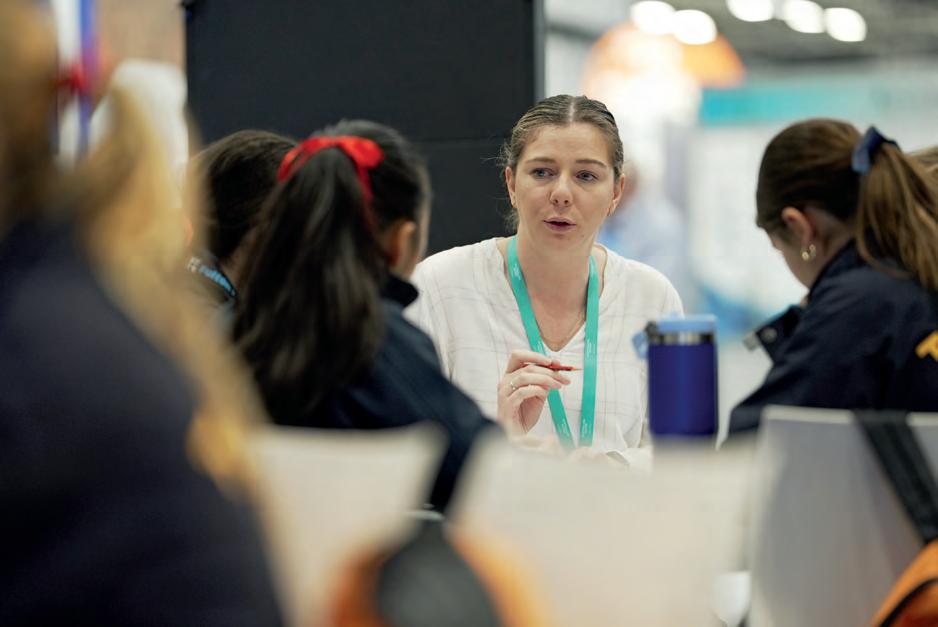
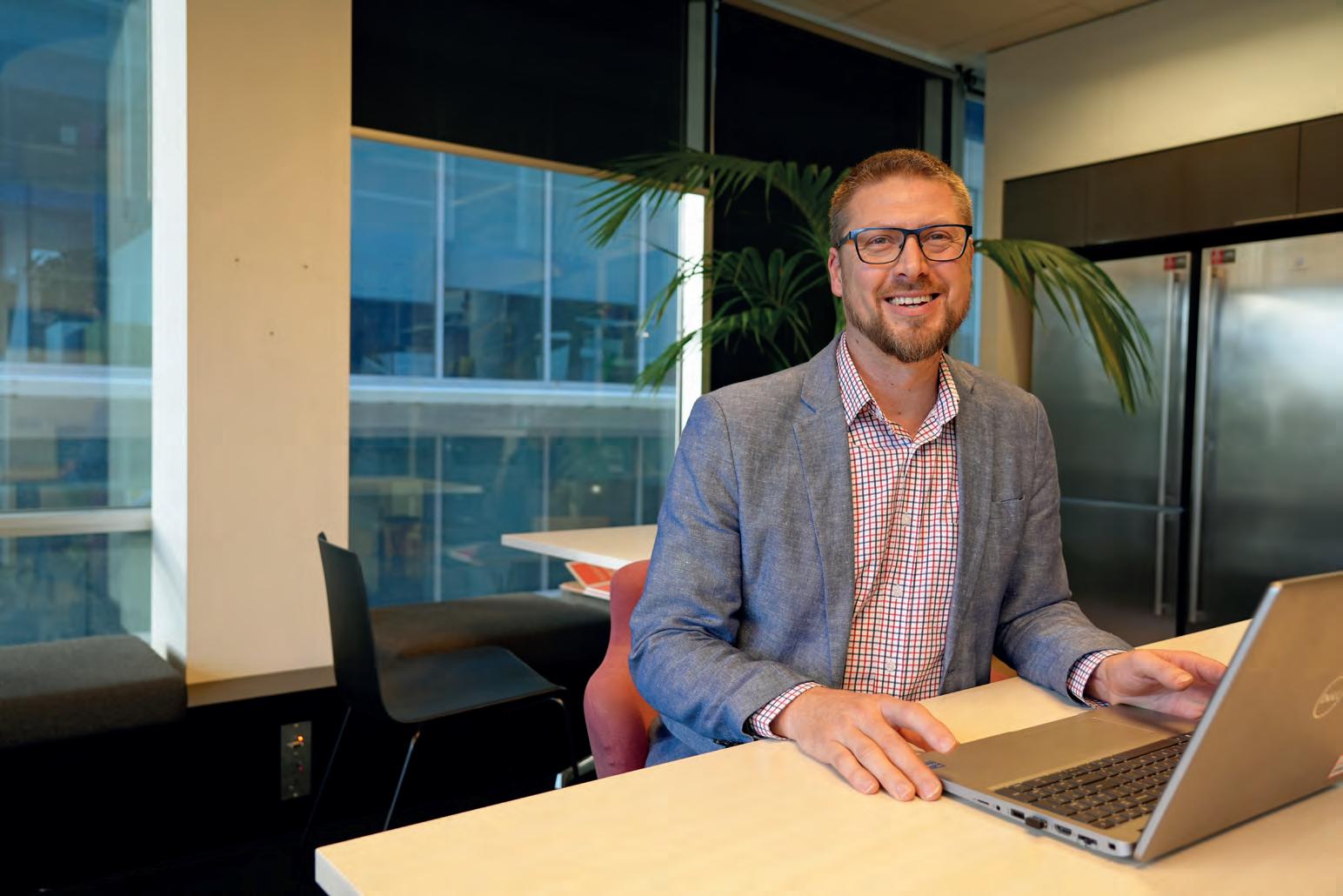
up to be group leaders, they’re the ones coming up with the really interesting ideas,” Evans says.
“It’s offering something completely different. Problem-based learning lets the students group up in their interests. There might be a group who want to handle the environmental considerations, some might be looking at the designs, while others might want to handle the relevant calculations. You can have an entire classroom, or even two, working in complete unison.”
Once each group had developed a solution, the entire Fulton Hogan STEM team got together to watch student presentations. Interestingly, solutions from the students were even considered for the real-life project, with previous solutions considered for implementation on major works.
“All of a sudden, the kids are leading their own education. The teacher is there to help guide, rather than instruct,” Evans says.
“That first program was extremely successful. Christie went from being told that this program probably wouldn’t work in primary schools, yet now it forms part of the curriculum in primary schools in South Australia. Christie and one of her colleagues
support students and provide them with some guidance,” Bowen says.
“If somebody from a construction company had come to my school that would’ve had a massive influence on my career and life decisions. If it was someone from a company like Fulton Hogan that presented information about career options in the construction industry, I would’ve said to myself that I need to knuckle down and get a good education.”
Bowen says the opportunities provided by the STEM program can help to create a clearer path to the sector at an earlier and more formative age, while also equipping young people with the knowledge, skills, and values they need to tackle the engineering challenges of tomorrow.
“When I left school, I was fortunate to have a direct entry into the industry through my father and grandfather, but a lot of other kids didn’t have those same opportunities. It’s a fantastic opportunity to open doors and give some of these kids an idea of what they want to achieve in life,” Bowen says.
The STEM program also has the potential to address the current shortfall of local and diverse talent entering the workforce.
Georgia Perry, Project Manager – Utilities
“ENGINEERING IS SUCH A BROAD TERM. YOU SPEAK TO A LOT OF PEOPLE, EVEN ADULTS, AND THEY DON’T KNOW WHAT ENGINEERING MEANS OR WHAT WE DO. THERE ARE SO MANY DIFFERENT AREAS OF ENGINEERING THAT WE CAN BE INVOLVED IN LIKE DESIGN, CONSTRUCTION AND PROGRAMMING. THAT’S WHY WE TRY AND GIVE THE STUDENTS A BIT OF EVERYTHING THROUGH THIS PROGRAM.”
were subsequently invited to develop all of the training videos that get released to schools. It’s been a great success.”
INSPIRING THE FUTURE
Following the success of the initial program, Evans set about expanding the Fulton Hogan lead problem-based learning model to other states in 2017.
Gavin Bowen, Program Manager – Utilities at Fulton Hogan, jumped at the opportunity for such a program to be shared in Queensland. Bowen says his interest in the program was initially a personal desire, along with the potential to inspire the next generation.
“I left school when I was 14. I didn’t really enjoy school and didn’t want to be there to be honest. When Dave came to me about the program, I saw it as an opportunity to
at Fulton Hogan, is relatively new to the program, just completing its second iteration in Victoria. But she’s already made a lasting impact, helping to officialise the program with an established structure and information package. Perry says this will enable important information around the problem-based learning model to be distributed with greater ease and accuracy.
“There were emails that were going around asking us if we wanted to volunteer and I jumped at the opportunity. It seemed like a great opportunity to do something different than our day-to-day work,” Perry says.
“It’s only been running for the past two years in Victoria, so we had a clean slate to start with, but also the guidance of the other programs that have been successfully implemented interstate. My first thought was, ‘let’s see what we can do, let’s make it


something bigger and better and we can go from there’.”
Similar to Bowen, Perry says the lack of similar programs when she was in school encouraged her to think about what kind of impact she could have on the next generation.
“I didn’t have any of these experiences in school, it wasn’t offered to us. It’s fantastic that we’re able to set something up for students coming through,” Perry says.
“Engineering is such a broad term. You speak to a lot of people, even adults, and they don’t know what engineering means or what we do. There are so many different areas of engineering that we can be involved in like design, construction and programming. That’s why we try and give the students a bit of everything through this program.”
Creating a sustainable sector, both in terms of pathways and a workforce coming through, on top of the utilisation of sustainable materials, are notions that Fulton Hogan is hoping to accelerate through this program.
And the success is there for all to see.
“From the first year to the second, we went from 30 students to 82 in just 12
months, which is huge,” Perry says.
“It’s a two-way relationship and the students have fun because of that. Fun is a big element of our sessions, and it enables them to become more engaged and more interested. We’ve set a good foundation moving forward and there’s still ways that we can grow and improve the program.”
Obviously for many students in late primary and early secondary school it can be difficult to determine what their given career will be, but Perry says for some, the signs are already showing.
“We have some standout students where you can already see that they’re thinking and excelling in the program. Some of the conversations that I have with them are well past what I thought they would be able to comprehend,” Perry says. “There’s definitely future engineers within some of these groups.”
Perry adds that the program is a great way of providing representation, ensuring that children of all ages, backgrounds and gender can succeed in what is a diversely growing sector.
“You can’t be, what you can’t see. Being a female in engineering has been a huge consideration in my involvement in
leading the program in Victoria. It’s really important to have that role model aspect to the program and it’s not just myself, we’ve had plenty of other team members and guest speakers who have touched on these opportunities for female engineers,” Perry says.
“It’s all about getting young girls and students excited about a potential career in STEM, creating a sustainable flow of female representation throughout the industry.”
Many participating schools also neighbour Fulton Hogan facilities and project sites, a constant reminder of the organisation’s commitment to not only local communities and economies, but also opportunities for those entering the sector.
Bowen says he’s seen the same behaviours during some of his programs.
“In a nutshell, what I appreciate the most is being able to share our experiences and knowledge to keep our wonderful industry moving forward,” Bowen says. “It’s all about that opportunity. Even if it’s one kid out of a class of 20 that enters the sector, that’s still fantastic. That’s why I like the Fulton Hogan STEM program so much. It’s giving these kids that opportunity to chase their dreams. What more can you ask for?”

You’re in control

Create your vision

SOLUTION A HAND-IN-HAND
BENTLEY SYSTEMS AND WSP ARE HELPING THE INFRASTRUCTURE SECTOR SMASH THROUGH POTENTIAL BARRIERS CONCERNING RESOURCES, DATA AND OTHER
Demand for infrastructure being at an all-time high, along with fierce competition for resources, continues to place pressure on the sector.
Adopting new strategies in infrastructure planning and delivery is now more of a requirement than an opportunity.
Bentley Systems’ recent Illuminate event aimed to help the sector respond to emerging challenges, covering areas such as infrastructure intelligence, sustainable digital delivery, and infrastructure resilience.
Speaking at the event, Paul King, Director, Product Solution Engineering at Bentley discussed these typical challenges that are enduring in the sector. He says there are many issues, but most can be grouped into three key areas: complexity, resources and data.
“In terms of project complexity, designs are getting more complex. There are many large infrastructure projects in Australia with challenging conditions and complex designs, but there’s also complexity in the supply chains regarding the joint ventures that are assembled to deliver these big projects,” King says.

King, Director, Product Solution Engineering, Bentley Systems speaking at the company’s 2024 Illuminate Conference.
“You end up with two or three contractors and two or three designers, some of which are overseas. You have all these teams trying to work together, manage all this information, design the complex infrastructure, and then build it.”
King adds that on the resourcing side, the sector doesn’t have enough skilled and experienced engineers globally, a glaring aspect that’s been seen in Australia with the pipeline of infrastructure work.
“It’s hard to get the right resources,” he says. “We’re having to recruit from overseas and fight hard to retain the good ones that we do have. But also, in terms of equipment and materials, it’s hard to get things like tunnel boring machines. There aren’t many of these around the world, and
trying to secure one for your project can be difficult.
“Inflation is causing the cost of materials to rise. We’ve seen this at a domestic level, with many house builders and small contractors going bust because of rising costs. This issue applies to mega projects as well; the price of everything is going up.”
In his address at Bentley Illuminate 2024, Steve Brogan, Infrastructure Australia’s Chief of Policy and Research, highlighted the impact of such costs.
Through he and his team’s research, he found that the infrastructure sector has a projected shortfall of 229,000 public infrastructure workers.
So, how can the sector do more with less?
WORKING TOGETHER
The relationship between Bentley and infrastructure delivery specialists WSP, which is represented by an enterprise agreement, is in many ways reflecting the
light at the end of the tunnel for smart infrastructure delivery.
WSP has optimised its operations through the use of programs such as ProjectWise. Built for infrastructure projects of all sizes, ProjectWise provides digital design delivery, portfolio intelligence, data governance and engineering work in progress to enable users to manage, engineer and validate.
An example is WSP’s recent works on the North East Link program in Melbourne, where the infrastructure delivery company formed part of the South Alliance. As Bob Freeman, Information Management Lead, WSP in Australia explains.
“Collaboration is hugely important in managing information correctly to avoid mistakes. It’s challenging, particularly on an individual level, to demonstrate the value of avoiding mistakes and using information correctly,” he says. “Essentially, if you perform well, the project runs smoothly, and no one ever knows. However, if you
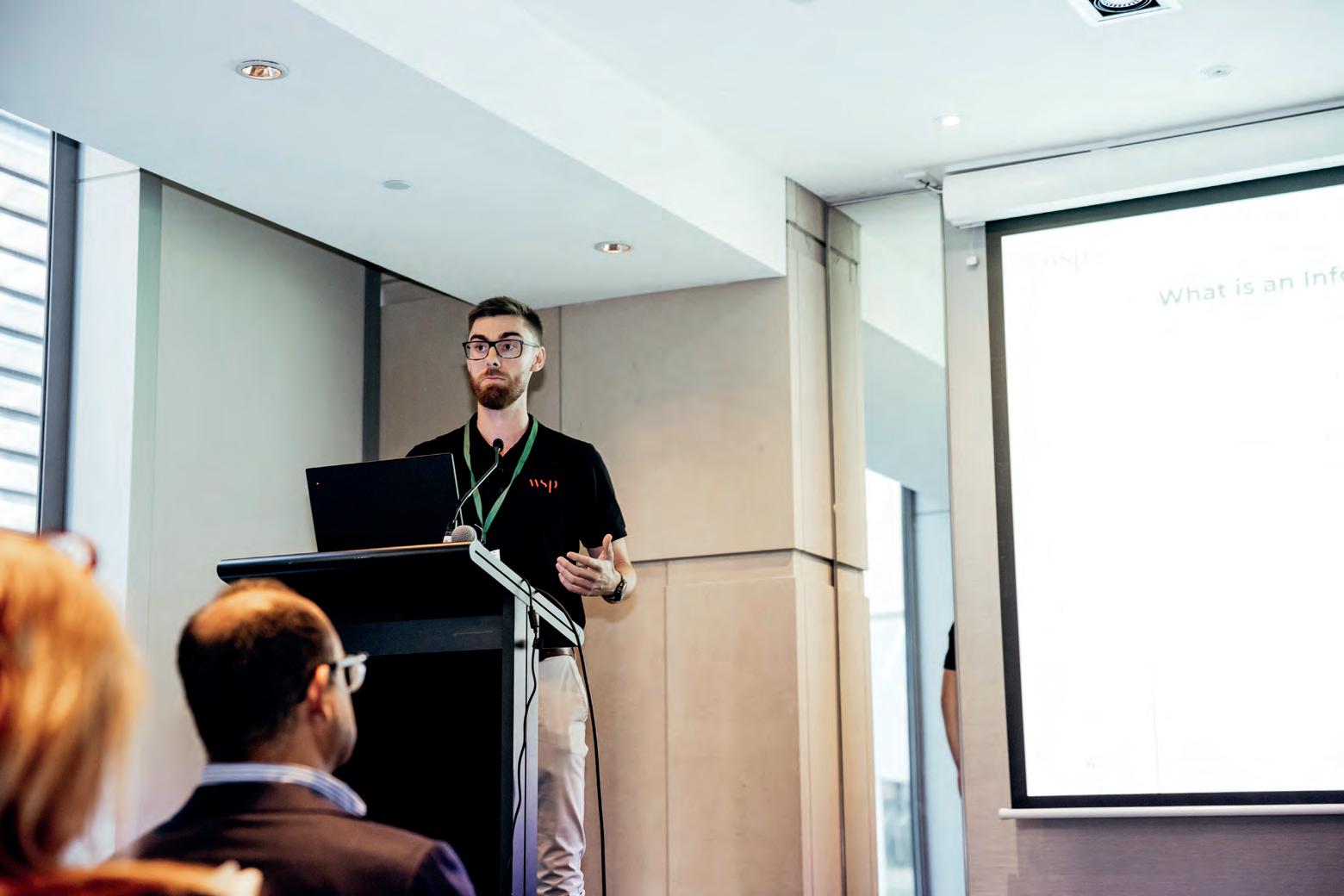
don’t manage your information well or collaborate properly, problems will arise on site.
“Managing information with tools like ProjectWise, following processes such as ISO 19650 and utilising the common data environment are very beneficial to our standard ways of working. We aim for consistency across projects, whether it’s a mining project or a transportation infrastructure project. Consistency in processes or tools, like ProjectWise, allows us to have a more adaptable workforce.”
But data is not nearly as effective without context or direction. It is especially important for an organisation such as WSP, which has 70,000 people placed globally covering a number of different disciplines.
King says Bentley puts a lot of effort into helping to minimise these associated complexities.
“The sheer amount of data available for projects nowadays is immense,” he says. “Designers and contractors are realising the value of data compared to old paper drawings and documents. However, managing this vast amount of data can be overwhelming.
“There are various sources of data, such as IoT feeds, photogrammetry, aerial surveys and points clouds, all of which
need to be managed. While there is significant value in this data, the challenge lies in making sense of it, organising it effectively, and getting value without being swamped by it.”
Another example is Bentley’s iTwin Platform, which allows teams to work in their preferred applications and seamlessly convert data into a shared database, promoting openness, transferability and reusability of data throughout the project lifecycle.
Due to these technologies, sharing information between different applications and platforms has become increasingly seamless.
On top of efficiency and productivity improvements, another benefit of technologies such as ProjectWise is more sustainable project delivery. It not only provides more value for clients, but it also creates a greener company legacy.
WSP’s aforementioned North East Link program benefitted from carbon assessments, focusing on lifecycle carbon emissions or energy emissions. Organisations like WSP can integrate carbon assessment into their design process and analyse individual components. With all the design content already available, adding carbon content is increasingly feasible.
we’re considering a broader range of talents, including technology specialists, programmers, and data analysts,” Freeman says.
“Another benefit is that universities are adapting to this shift. Civil engineering degrees, for instance, now incorporate computer science and programming subjects. We’ve got people coming in that are more prepared for the demands of the industry, which is great.”
Freeman believes that the use of technology will be a powerful complementary tool, rather than a replacement to conventional methods and staffing. As such, he says the sector should be excited for potential outcomes and improvements that lie ahead.
“In engineering, it used to be challenging to visualise the final product; you had to rely on drawings or reports. Being able to rotate around and immerse oneself in a project is incredibly powerful,” he says.
“When I was chatting to our CEO of Australia, Greg Kane, he said, ‘AI won’t take your job, but an engineer using AI will.’
“We’re in a bit of a flux at the moment where people are questioning whether this digital transition is really here. We’re about to hopefully see the productivity benefits of going digital skyrocket.”
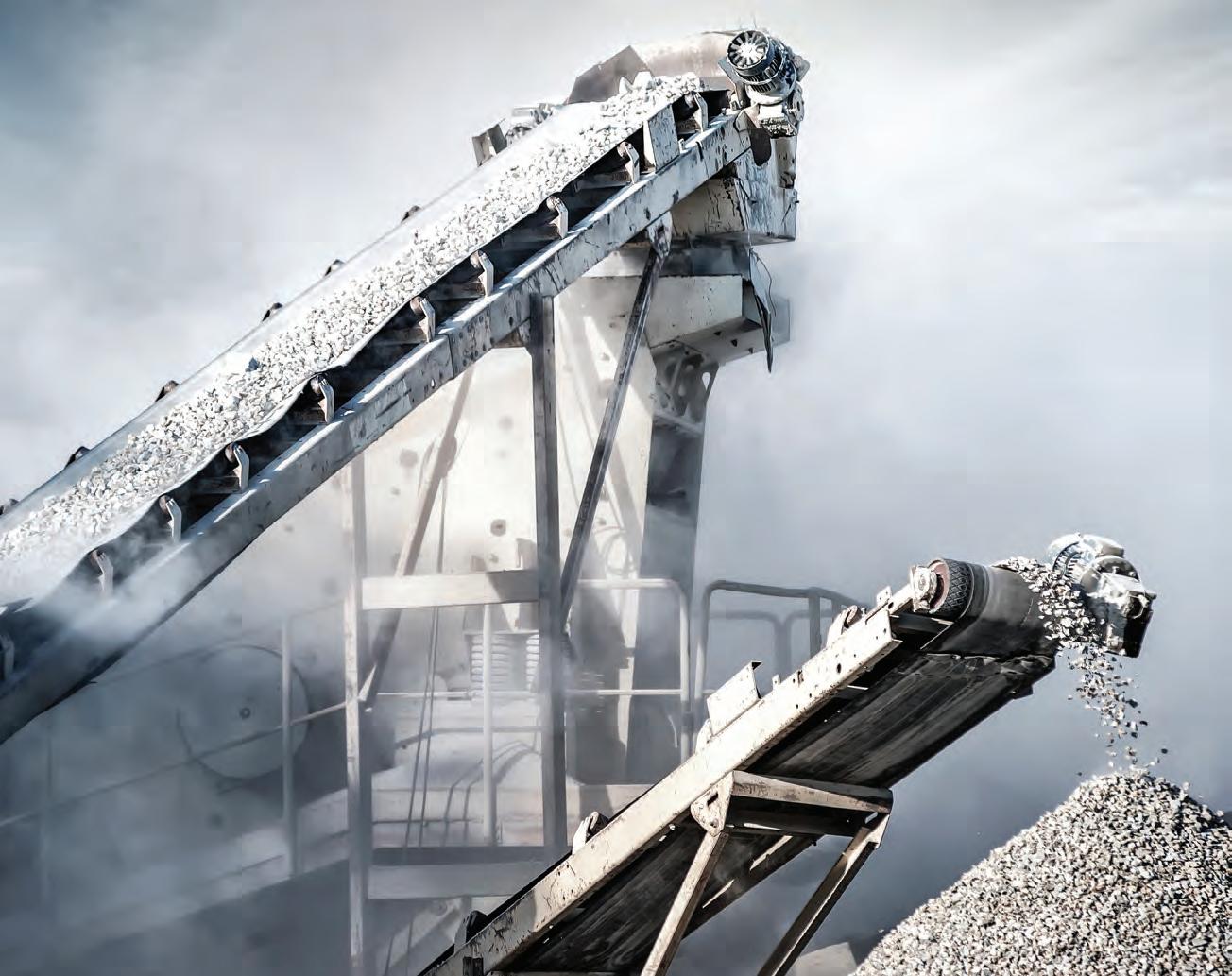


BULK HANDLING EXPO
A DIGITISED INDUSTRY
ROAD REGULATORY PROGRAMS CONTINUE TO EXPAND ACROSS AUSTRALIA’S TRANSPORT NETWORK, WITH INTERNATIONAL EXPERTISE BEING ADOPTED BY LOCAL AUTHORITIES FOR THEIR IMPLEMENTATION. WHAT ARE THESE PROGRAMS AND WHAT DOES THIS ADOPTION MEAN FOR AUSTRALIA? ROADS & INFRASTRUCTURE TALKS TO TELETRAC NAVMAN TO FIND OUT.
Regulatory programs are an extremely useful method of accurately assessing the health, size, and room for improvement of road networks on a local and national level.
Teletrac Navman specialises in the development and design of telematics – a method of monitoring an asset by using GPS and onboard diagnostics – considered an essential piece of the road regulatory program puzzle.
Teletrac Navman’s Solutions Specialist, James French, says regulatory programs can be beneficial for road users and their agencies who rely on data provided by said programs and schemes within to dictate future transport decisions and funding.
“When you look at a job site, it’s a very dynamic environment. It can be difficult to manage all the data that’s coming out and to get the technology that you need to influence the outcomes of a project,” he says.
“It can be a big challenge to find something that works around what you’re trying to achieve. What’s available? How can I marry my goals with what’s available? Those are the questions that need to be answered.”
While technology is changing rapidly, the introduction of regulatory programs continues to influence project outcomes.
“For regulatory requirements, such as RIM (Road Infrastructure Management), you don’t have to opt into it – they’re not mandatory,” French says. “You can stay out of it and that’s where people question what’s the cost and what happens if we stay out of it?
“They’re looking at the impact instead of where the benefits are. I think there’s still a bit of reverse engineering there in some way, rather than people taking the benefits and seeing how it can work for them.”
The benefits can be considerable for participants, with exclusive access to road networks, increased freight limits, and increased freight drop off speeds, to name a few.
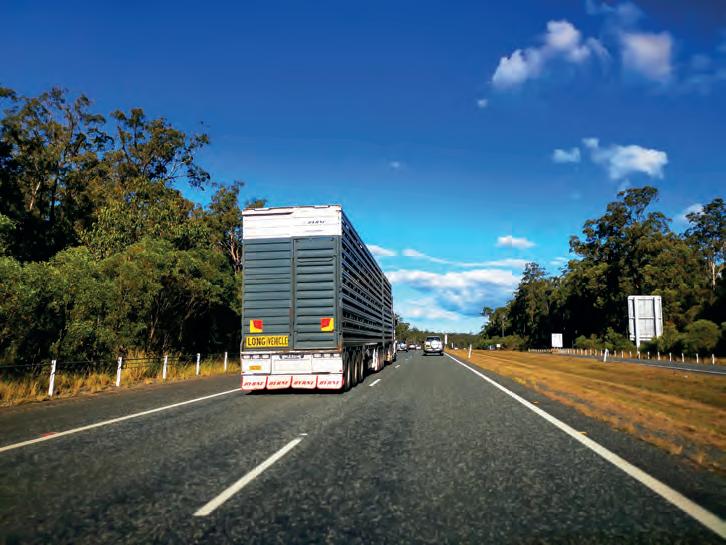
FOR YEARS TO COME
“When it comes to sustainability, if we can rely on the information that’s been extracted from RIM, road agencies and managers can understand which roads are being used more frequently than others with heavy traffic,” French says.
“When considering repairs and designing roads, you can start to build up that information. If you have information about the type, weight, speed and volume of traffic, then you can start planning roads earlier. Helping to design roads that can last longer and support heavier traffic volumes.”
Reducing the need for materials and resources to repair roads is just one aspect. Another is supporting local economies.
As well as being a visual aid, data can be interpreted to understand how heavy traffic is impacting a community, potentially where the road network is struggling to cater for heavy traffic.
Providing alternative routes for heavy vehicle traffic can be a catalyst for community growth.
“One of the first things you’ve got to look
for works, what impact will that have on the café down the street?’ Things like that can come up frequently during infrastructure planning,” French says.
“If there’s less heavy vehicle traffic in an area, I’d think it’d be more conducive to business and general living.”
Disproving or confirming the potential impacts of a project on factors such as the local economy, sustainability and local traffic can all be aided by the data provided through road regulatory programs.
“Whether it’s using cameras, telematics or other technologies, pulling this data is really important for many of these infrastructure projects because you have to consider the impact that you could be having on local residents, businesses and even government,” French says.
“When you’re using RIM and getting accurate data through regulatory telematics, you can have multiple data sets coming from multiple locations. When you start pulling this data, both historically and in real-time, you can build a better picture of the impact that you’re having.”
ON THE CLOCK


A notable development in this space has been the emergence of ‘CLOCS-A’. Construction Logistics and Community Safety – Australia (CLOCS-A) is described as a national approach to managing risks and impacts associated with construction works.
CLOCS-A is the Australian version that’s based off the successful CLOCS program introduced in the United Kingdom, which led to reductions in the local road death toll as well as the number of serious injuries.
Australia is undergoing an unprecedented $200 billion major infrastructure build in cities for at least a decade. And key to its success is trucks, without them none of these can be delivered.
This means more trucks on community roads and increased risk of interactions between them and cyclists, pedestrians and motor bike riders. People make mistakes when on the roads and when it involves a truck it is often fatal. CLOCS-A is about reducing the impact of these mistakes such that all road uses are more aware and understanding and tolerant of each other on the road.
By enabling industry professionals to achieve best practice in managing construction logistics, CLOCS-A can provide a consistent framework.
Under the Commonwealth National Road Safety Strategy Action Plan, the implementation of CLOCS-A is set to be supported by the states and territories. The
Federal Government is also expected to implement the CLOCS-A standard and/or ISO 39001 Road Traffic Safety Management Systems to construction projects that are federally funded.
“It provides more of a focus around productivity and safety. Businesses can do what they need to do quicker, and therefore, the community is impacted less,” French says.
“It helps to safeguard what’s happening on these sites to make sure it’s in a manner that’s not going to affect the community. That’s everything from traffic, right through to outages, everything is managed.
“There’s technology behind every element.”
This is just one technological element being deployed in one specific sector. There’s potential for a national adoption, which could result in safer outcomes and unity regarding road trauma and serious collisions near construction sites.
French says CLOCS-A can help to ensure that safety is a paramount concern for project delivery, even as faster lead times and shorter project timelines are required.
“As a society we’ll continue to need infrastructure quicker and larger than ever as the population grows. That’s why it’s important to drive that flow of productivity and efficiency,” he says.
The structure of CLOCS-A differs from other regulatory programs. For example, a program such as RIM or TMA can consist of hundreds of individual schemes.
Regulatory programs continue to expand in Australia, with the adoption of international programs also helping to assist implementation.
Whereas CLOCS-A consists of three different ‘standards’ – bronze, silver and gold.
“Each one is dependent on what you need, what you’re building, the infrastructure around it, and the risks involved, as well as the prerequisites,” French says.
There are multiple requirements such as heavy vehicles, drivers, logistics planning, and communications.
Just some of the project variables include (but are not limited to) total project cost, usual residential population density, daily heavy vehicle visits to site, traffic density, as well as the location of site entrance, school zones and shopping centres.
Companies looking to achieve a gold ranking will be required to show considerable investment into safety and logistical technologies like ARB (Autonomous Reverse Braking), AEBS (Advanced Emergency Braking System) and RSC (Roll Stability Control for Trailers) for heavy vehicles.
While information for authorities and organisations in the construction space is slowly coming to hand, French believes that more information will come out when CLOCS-A is applied to real world settings.
“When businesses start implementing it and working together, we’ll start to see the benefits,” French says. “A lot more of this will come into effect once its applied to projects. The more it’s implemented, the more we’ll learn.”
AGRICULTURE FARMING EDUCATION WASTE MANAGEMENT RESOURCE MANAGEMENT
CONSERVATION MANUFACTURING RESOURCES
ENERGY HEALTH & SAFETY INFRASTRUCTURE
ENGINEERING MINING CONSTRUCTION
QUARRYING AGRICULTURE FARMING EDUCATION
WASTE MANAGEMENT RESOURCE MANAGEMENT
CONSERVATION MANUFACTURING RESOURCES
ENERGY HEALTH & SAFETY INFRASTRUCTURE
ENGINEERING MINING CONSTRUCTION
QUARRYING AGRICULTURE FARMING EDUCATION
WASTE MANAGEMENT RESOURCE MANAGEMENT
CONSERVATION MANUFACTURING RESOURCES
ENERGY HEALTH & SAFETY INFRASTRUCTURE
ENGINEERING MINING CONSTRUCTION
QUARRYING AGRICULTURE FARMING EDUCATION
WASTE MANAGEMENT RESOURCE MANAGEMENT

SEARCH FOR TOP INDUSTRY TALENT THROUGH OUR JOBS BOARD. CONNECT WITH ALIGNED CANDIDATES.
BOOST YOUR CHANCES OF FINDING SKILLED APPLICANTS.
SCAN TO CREATE AN ACCOUNT TODAY AND DISCOVER YOUR PERFECT MATCH!


DOWNSIZING WITH PURPOSE
SPECIALISED ROADING EQUIPMENT’S NEW TELESCOPIC SPRAYER REPRESENTS THE EVOLUTION OF THE CONVENTIONAL FIXED WING DESIGN, GIVING CUSTOMERS A NEW FOOT IN THE DOOR TO THE SPRAYING WORLD.
Two thousand kilometres may sound like a massive distance, but for New Zealand-based Specialised Roading Equipment (SRE), the distance to Australia feels much closer.
The company continues to leave a lasting imprint on the Australian road construction machinery market, with its reputation and volume of units growing daily throughout its adopted home country.
For years, SRE’s focus on delivering machinery suited to large infrastructure works has been a key driver in this growth under the tutelage of Managing Director Mark Wansbrough. Now the company is looking to leave its mark with smaller, more agile and cheaper machinery.
So why downsize when you’ve mastered the formula? For Wansbrough, the answer is simple – SRE doesn’t rest on its laurels, instead the company is driven by the constant chase for improvements in accuracy, quality and output. Even when these improvements are quantified by just millimetres.
“It’s the type of sprayer that can completely transform a business. For the ambitious out there that have a dream, this is in many ways their first step into the spraying world,” he says.
“For the larger corporates, it’s the perfect specialist tool. For those with a smaller operation, it’s their mini-Swiss Army knife. For the Australian market, we’ve now got a complete telescopic offering that covers all of the bases that our customers are after.”
The four-metre telescopic sprayer combines most of the well-known technology of the larger 4.5-metre and six-metre models with a compact and manoeuvrable model, while also being more cost-effective and efficient.

Specialised Roading Equipment’s fourmetre telescopic sprayer provides a compact yet powerful spraying
This is due to SRE’s unique design direction, which focused on taking what worked best from previous models and simplifying even further. One good example of this was the user interface.
The added benefit of a downsized system
is compatibility and ease of use between different models. Each of the four-metre, 4.5-metre and six-metre sprayer models feature a similar user interface, making operation interchangeable between each unit.
Simplifying the user interface enables, spraying specialists to open up a wider pool of potential employees in terms of experience and knowledge requirements. As Wansbrough explains.
“It gives operators the ability and freedom to move between our different models and operate with confidence,” he says. “We’ve been hearing that a lot of companies in Australia have been struggling to find suitable operators. This unit opens up the ability to find more people. The simpler design is easier for people to get their heads around.
“Hopefully it’ll lead to our customers being able to put more drivers in more seats.”
As a dedicated bitumen emulsion sprayer, the four-metre version is designed directly to deliver maximum agility and output for tack coat and maintenance work, on top of priming.
“It’s all about recognising what is the best tool for the job at hand,” Wansbrough says. “You don’t necessarily need to bring your massive sprayer for these types of jobs. The right tool generally is a smaller sprayer that can deliver most of the spraying capability. That’s the beauty of the four metre.
“There’s a big section of the market that does a lot of this tack coat and prime work. It’s about making sure that they have a tool that’s specialised for carrying out those works.”
Chris Kaelin, SRE Business Development Manager, says the four-metre telescopic

The four metre telescopic sprayer is ideal for the newer operator, as well as the those hoping to add greater versatility to their existing fleet.
sprayer is particularly impactful during tack coating works, delivering works in front of the paving crews.
“It’s a manoeuvrable sprayer that’s perfect at not only those types of works, but also your patching and smaller site jobs. Across the board it satisfies compliance requirements, including the spray flow certification test,” he says.
Downsizing also provided ample opportunities for improvements, such as flexible hosing, Kaelin says.
“Our SRE pump is optimised for emulsions, whereas the larger pumps don’t seem to handle the emulsion as well,” he says. “We like to run smaller pumps where possible to not only handle the emulsion better, but to also give the operator greater flow control when you’re using these machines.”
As with all of the SRE machinery range, the company can provide a training and tutorial service for operators of the new sprayer.
“That’s a major point of difference for us,” Wansbrough says. “We don’t just drop off the machine and say ‘there you go’. We want to make sure that the operator can use it effectively – and more importantly – safely.
“It’s a refined process so it doesn’t take long. The amount of time that we spend on the functionality depends on how the user operates, but it’s never a big leap to adjust to our machines. You get all the benefits of a fixed-wing sprayer and other functionality can be replicated through our system. It’s about making the transition easier so the operator can hit the ground running.”
Kaelin, who heads up the delivery of these detailed training programs, says it’s satisfying to see machines deliver in real life applications that have been designed in-house.
“You see some businesses where people have been thinking for a while about purchasing our sprayers,” he says. “Once we get on site and they see what it’s fully capable of, you can’t help but have a grin on your face.”
For operators that are new to the spraying sector, this latest sprayer is a great introduction. And for those looking to add greater versatility to their existing fleet, this unit could be the answer.
“For those smaller guys, it can be everything that they need when it comes to edges and smaller patching contracts for their local councils. For the larger contractors, it’s a great speciality tool,” Wansbrough says.
“It’s the ultimate tool that ticks all of the boxes.”
NO-DIG DOWN UNDER
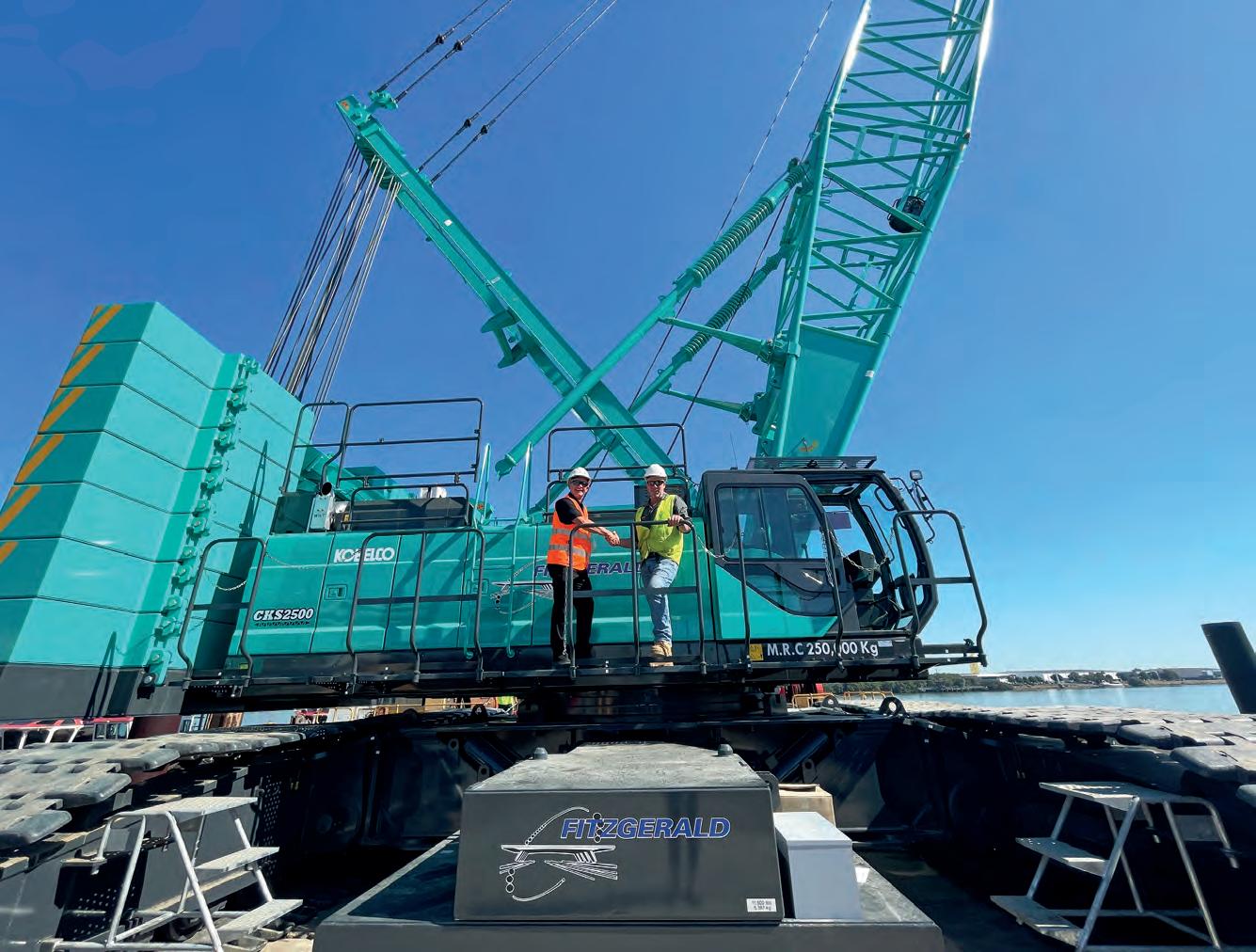




TRT has a long-standing relationship with crane manufacturer Kobelco, with both companies sharing an appreciation for quality, sustainability and customer satisfaction.

HAND IN HAND KOBELCO AND TRT:
TIDD ROSS TODD’S (TRT) LONG-STANDING DISTRIBUTION PARTNERSHIP WITH KOBELCO CRANES HAS ENABLED OPERATORS IN BOTH NEW ZEALAND AND AUSTRALIA TO ACCESS HIGH QUALITY, INNOVATIVE UNITS, CAPABLE OF DELIVERING INFRASTRUCTURE WORKS OF ALL SIZES.
Tidd Ross Todd (TRT) is a company that’s synonymous with providing next-generation crane technology and machinery to the market. A key part of this continued success is its relationships with crane manufacturers from across the world.
Among its most valued relationships is its established partnership with Kobelco Cranes.
In 2020, TRT was announced as the new distributor of Kobelco Crawler Cranes, kicking off a new era for both organisations. This deal included permissions to distribute Kobelco machinery across New Zealand, Australia, Papua New Guinea, New Caledonia and Fiji and further added to TRT’s experience with Kobelco manufactured units.
This agreement also stated that technical information, parts supply and sales of new cranes would come from TRT, providing greater access and supply of necessary support services.
Fast forward four years and the relationship is as strong as ever.
Whether its Lattice Boom Crawlers, HeavyDuty Crawlers, Telescopic Boom Crawlers
or crane trailers, TRT’s range carries across a number of Kobelco model types, for different disciplines.
Kobelco’s Heavy-Duty Crawlers, for example, are suitable machines for foundational and civil engineering works for construction projects.
Both companies see eye-to-eye in this space, Troy Hand, Crane Sales & Pacific Islands Manager – TRT says. He adds that the Kobelco name represents quality and reliability. Similarly, so does TRT’s.
“Both brands have known each other for so long now, there’s a deep understanding there,” he says.
“We’ve got a lot in common. We both manufacture in-house, there’s some good synergy around the supply chain also, and we’ve both got a thorough understanding of what’s required. Many of our team, including myself, have also had a lot of experience with the Kobelco name and brand.”
This experience stems from Hand’s past as the former owner of B&N Cranes, which was purchased by TRT. B&N Cranes was a certified
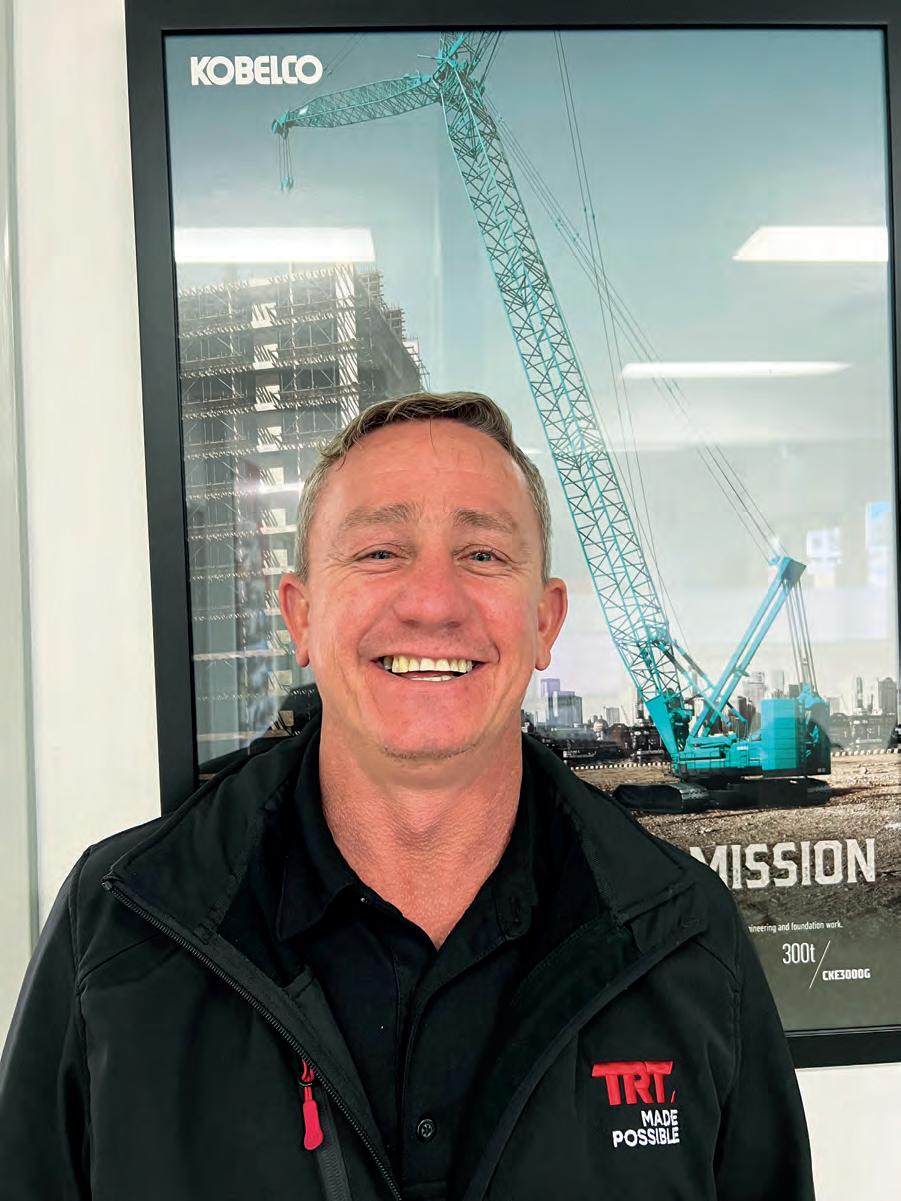
Kobelco service agent, as such many of the B&N Cranes team were able to bring across their Kobelco experience to TRT in order to maintain high-quality service and support for its clients.
TRT provides services when it comes to support and maintenance including, but not limited to, inspections, crane repairs and insurance repairs, even major rebuilds where required. Hand says this reflects TRT’s focus on keeping customers lifting by minimising downtime wherever possible.
On top of its experience manufacturing, TRT has five decades experience of providing maintenance and parts in-house, with only OEM-trained experts handling most crane types, sizes and brands including Kobelco.
“We purchase all of our patented Kobelco parts from their manufacturing sites. People who require maintenance and parts can then just come straight to us for support and general servicing,” Hand says.
“When you hear someone say ‘Kobelco’, straight away I think of the value for money, the support network on offer, the simplistic design and the diversity of their crane models.
“Its reputation is built around reliability. That’s consistent across the entire Kobelco range, so an operator can really easily
move between different models. That familiarisation is there, helping businesses to easier upskill their employees.”
TRT’s range of Kobelco cranes are built tough for tough environments, while also being easier to move between jobs. This is thanks to a design dedicated to reducing the required time and costs between set up, breakdown and transport. As Hand explains.
“They’re not just a general hire machine and they’re not just for the weekend warrior. You can grab it and transport it to the next job, all in a single day, making it ideal for infrastructure and construction. These cranes are suited to complete major works in a variety of applications and situations,” he says.
Longevity is another factor in the success of Kobelco’s crane units. This is the result of a compact and minimal part-use design.
“A crawler crane will usually have less parts than an all-terrain crane and the Kobelco design is so simple, giving a significant reduction in maintenance costs. It’s got that Japanese workmanship quality in every unit. That quality extends to both the interior and exterior of each crane,” Hand says.
“It’s also a low crane in terms of overhead. When you walk out the door with one of these units from a TRT dealership, you can know that you won’t need to keep covering
costs and walking through the door for continued repairs and upkeep.”
The longevity of these machines is a factor that can be felt even in Hand’s day-to-day customer interactions.
“Just the other day I was talking to a customer who’s had a Kobelco crane for more than 12 months and I’ve barely heard a word. All they’ve had to do is change some filters and that’s it,” he says.
“With these units you can escape major and even frequent maintenance intervals. The machine looks after you, you take care of the rest and that’s all in the quality, the controls and the overall preciseness of the machine.”
In total, there are 22 crawler crane models that are available from across the Kobelco range. The designs of many of these machines can be tracked back to the company’s origins in the 1930s.
Hand says the technology in each of these units has come a long way since those early days. That trademark Kobelco focus on efficiency and performance hasn’t gone anywhere.
“It’s that simplicity that really makes a difference. You can have everything, without overcomplicating the machine. It doesn’t need to be overcomplicated to deliver on this,” he says.
“Each of these components are very well tested in the factory. The levels of quality assurance control are amazing. For both TRT and Kobelco, the thinking and desire is to have each unit type tried and tested before the end user even receives it.”
For Hand, Kobelco has long had a presence in his life on a personal level, with his previous company that he owned having used Kobelco equipment. He says that personal touch is something that he’s always keen to reciprocate with his own clients.
“I’ve got a lot of appreciation for a lot of their people,” he says. “It’s been a big part of my life. Funnily enough, back to 2006 when I was doing my first bit of training at Kobelco, the instructor’s son that I had now works there as well. I’ve gotten to watch people I know climb the ranks and excel in their own positions.
“TRT and Kobelco feels like a big family, everyone makes you feel really welcome. There’s a lot of trust, and I know that every time I deliver a Kobelco unit to one of our customers that they’re in safe hands, and that they’ve made a smart investment.
“I can rest easy knowing that each and every customer will be looked after by both parties.”











PAVING AHEAD WITH THE CAT® AP400
STRONG FOCUS, LISTENING TO CUSTOMERS AND INDUSTRY, INNOVATIVE AND SUSTAINABLE PRODUCTS. THAT’S WHAT CATERPILLAR STANDS FOR.
Caterpillar prides itself on connecting with reputable dealers. Many Cat® dealers operate locally and create customer relationships that go back generations. Such a commitment to excellence is reflected in everything they do.
Dealers such as Ryan Van Den Broek from Hastings Deering in Queensland, who look after Daniel Betts from Tanners Bitumen & Asphalt, show how effective these partnerships can be.
THE CUSTOMER
Tanners Bitumen & Asphalt is renowned for its reliability and efficiency in providing bitumen, asphalt, and roadwork services across central Queensland. With bases in Rockhampton and Yeppoon, its priority is
to deliver top-notch services to its valued clients, including private, commercial, and government projects across the region.
“My partner and I bought the business four or five years ago,” Betts says. “I was in earthworks before that, and my partner was managing telecommunication stores.”
When it comes to his relationship with Caterpillar, Betts is quick to point out that he has been using their machines since the company’s early days.
“Our first purchase was a CP34 Vibratory Soil Compactor,” he says. “Next came the AP400 and, most recently, the CB1.7 Utility Compactor.”
THE DEALER
Hastings Deering has more than 3000
employees across 23 business service centres throughout Queensland, Northern Territory, Papua New Guinea, the Solomon Islands and New Caledonia, with its headquarters in Brisbane.
Van Den Broek is the Industry Manager for Road Construction and Infrastructure and has been with the company for more than 10 years.
He keenly understands what his customers need.
“I’m a trainer, among other things, and more than happy to help customers prepare for their future operations,” he says. “It’s important for us to help our customers understand their machines and how to use them.”
Hastings Deering’s corporate purpose is to partner to build a better future.

It does this through partnerships with its customers, suppliers, communities, people, and shareholders.
“A better future is when we achieve no harm,” says Van Den Broek. “It occurs when our customers are delighted and more productive, when our suppliers are successful and when our people are rewarded through achieving their best.”
Van Den Broek is keen to highlight Hastings Deering’s footprint as part of the Cat dealer network.
“Our relationship with our clients and the support we provide our customers are central to what we do,” he says. “With the training and customer support that we offer, we want to ensure that we can continue to support the industry through our actions.”
THE MACHINE
The Cat AP400 is a wheel-type asphalt paver that provides easy transport, versatility, and a wide paving range. It is designed for urban streets, parking lots, rural roads, and many other small-to intermediate-type applications.

updates being implemented into the wider Cat asphalt paver range. As they get their updates, our customers can take advantage of improved firmware and software.”
from the AP400 ensures that we can get everything off one truck when we are heading into west and central Queensland. The AP400 is not too big or too small, so it fits seamlessly into the solutions we offer.”
According to Van Den Broek, customers are very happy with the machine because it fills a niche need.
“We have a few customers who have fleets of Cat machines, and the AP400 suits them perfectly,” he says. “It’s the first part of the new generation of Cat machines being distributed, and a lot of customers are saying that it fits the niche that they need.
Van Den Broek also points to the Cat AP400’s flexibility as a customer favourite. The AP400 has enough power for most jobs while being small enough to do the jobs that require closer attention.
Similarly, Betts is thrilled with the Cat AP400.
“One of our biggest issues is transport,” Betts says. “We need machines that we can move around urban areas and fit on
An additional aspect of the AP400 is the variety of projects it can take on. Smaller projects tend to have a wider variety of angles that are too tight for the larger machines. Equally, the smaller machines take much longer to complete.
“The AP400 hits the mark straight in the middle,” says Betts. “It is the perfect size for small jobs, but we can also take on larger jobs with the AP400.”
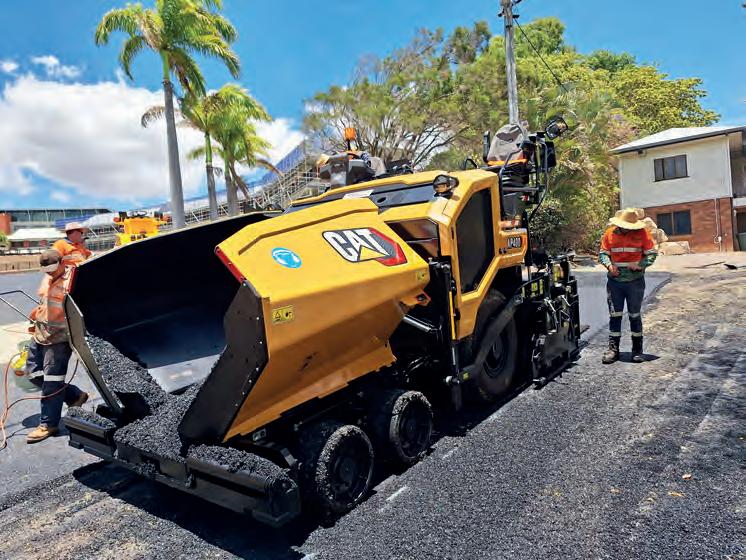
THE FUTURE
The Cat AP400 has been one of the most popular machines Van Den Broek has seen. Contractors of all sizes have been clamouring to get their hands on it.
“This could become one of our bestselling machines,” Van Den Broek says. “Bigger contractors want a more versatile machine, while smaller contractors want to step up in size.”
He reported that people were contacting Hastings Deering well before the Cat AP400 was released in Australia. In fact, the instant it was released in the United States, clients and customers reached out to Van Den Broek and his team, he says.
“I think what will happen is that the AP400 will take some sales from both the big and small machines and come together to become our best-selling machine.”
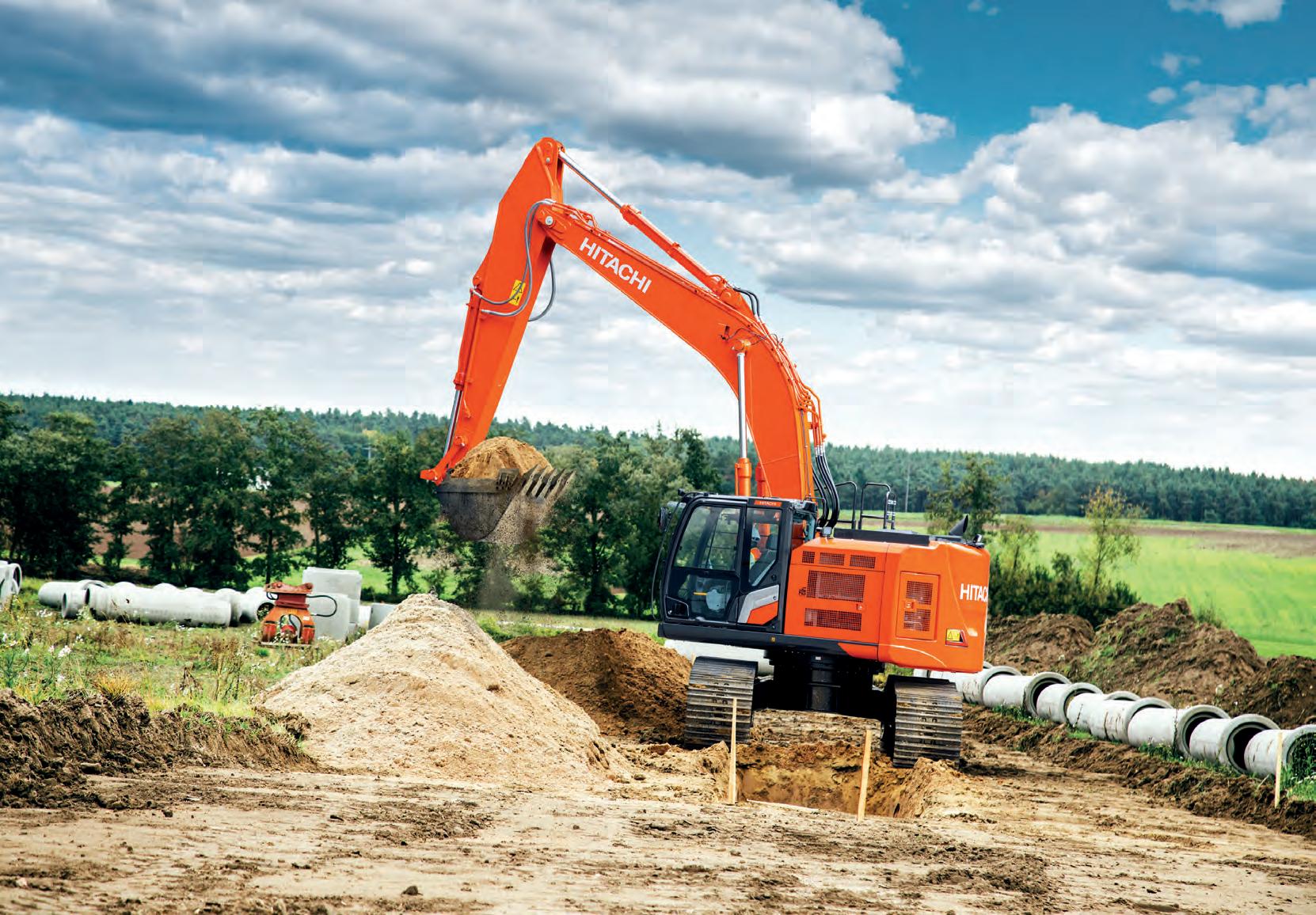
THE PICK OF THE BUNCH
HITACHI’S ZX345USLC-7 EXCAVATOR GIVES OPERATORS AN ULTRA-SHORT TAIL SWING RADIUS, WITHOUT COMPROMISING ON OUTPUT OR CAPABILITY. HERE’S HOW.
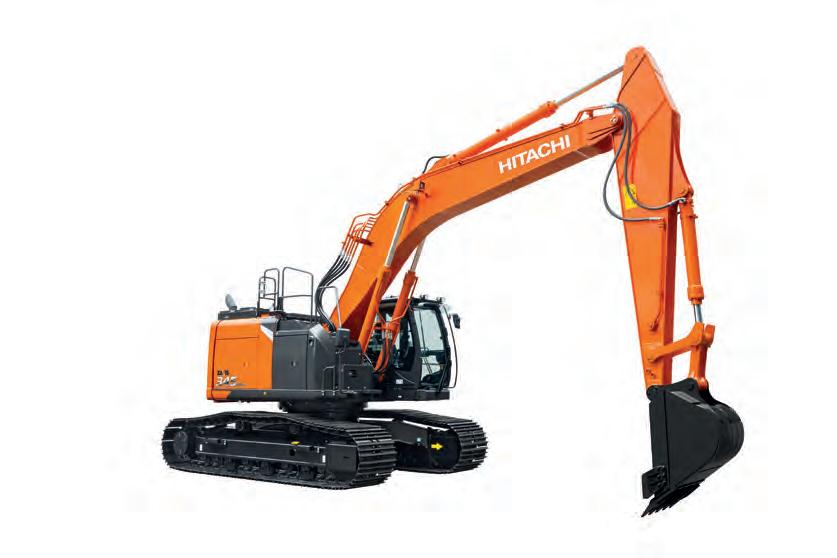
The iconic orange livery of Hitachi machinery is an easily recognisable staple of many construction projects across the world.
Founded in 1910’s Japan, the selftitled “orange family” specialises in the development of high-quality machinery that’s purpose built for the civil construction market, among other industries.
Hitachi has a range of excavators and wheel loaders equipment able to cater for a variety of different project sizes and types.
As part of the company’s push to satisfy modern industry requirements for machinery that’s versatile and powerful, while being compact, Hitachi is set to introduce its new entry for the mediumsized excavator market.
Following success of its ZX135USLC-7 and ZX225USLC-7, Hitachi is set to introduce the ZX345USLC-7 (35900 kilogram) is a part of these new entries that can be described as the one-stop-shop for a flexible excavation operation.
Bijesh Surabhi, National Product Manager, Construction Excavators –Hitachi Construction Machinery, says the ZX345USLC-7 provides the fastest cycle times in the sector, with its ultra-short tail

swing radius making it a suitable option for modern requirements and excavations.
“It’s one of the biggest advantages of this model. It gives the operator ease of use, and importantly, peace of mind while working in tight spaces. As the number of different types of projects has increased, especially urban projects, there’s a greater desire for a machine of this capability,” he says.
“There’s a huge potential within the ultrashort swing excavator market. Everyone already knows the Hitachi brand. It’s well known how well our excavators perform and that’s one of the main reasons why these machines were so popular at the recent BAUMA and CONEXPO shows.”
The promise of being able to work where other machines can’t is fuelled by Hitachi’s commitment and focus on power. Backed by an Isuzu diesel engine, capable of producing 197kW ( 264 HP), while also achieving Final Tier 4 emission standards, the ZX345USLC-7 can maintain the signature power and output of Hitachi excavators despite its smaller scale.
This has already been put to the test internationally, with this model among other new units that have become popular in the United States. Surabhi says if the success of those models is any indication, Australia is set to benefit from the next generation of excavator technology.
He attributes some of this success to the versatility and customisation that both Hitachi and the machine itself support.
“The utilisation and user interface of this model can be changed based on operator preferences. The operator can alter priorities between the boom and arm and attachment and even make adjustments to the boom and arm responsiveness while running heavy attachments. These changes can be made on the fly,” he says.
“It’s designed to react well to whatever these changes may be. Whatever the operator needs and wants to do with the machine, I have no doubt that they’ll be 100 per cent satisfied with its performance.”
The LCD monitor can provide detailed and concise information around the basics, featuring a refreshed control layout that enables quicker menu navigation. These screens are also anti glare.
An ergonomic design gives the operator increased controllability and confidence. This is also supported by greater comfort for the operator, with thicker glass and an improved design not only reducing
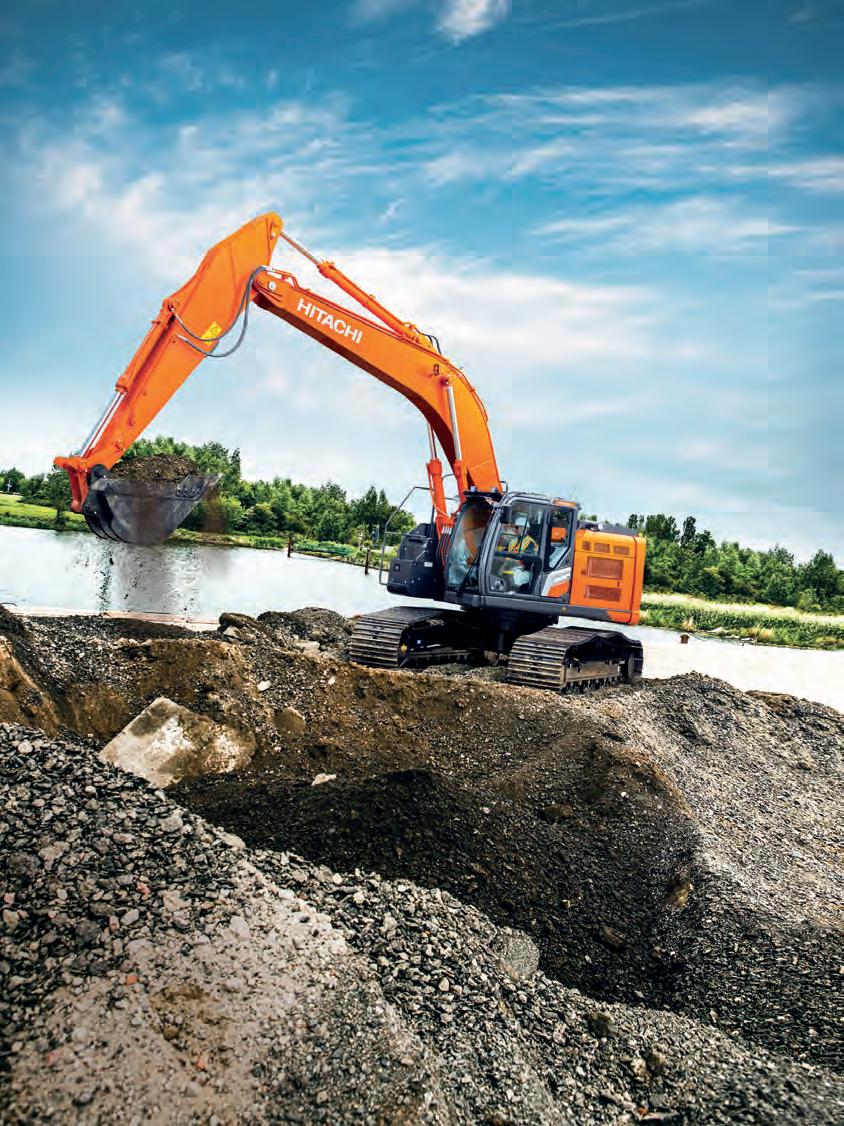
noise inside the cabin, but also bolstering increased seat suspension, while further reducing vibration.
One of the noted features of this machine is the enormous cabin in-spite of the short tail full size cab similar to the conventional size machines. Increased visibility can also provide more comfort and ease of use – and importantly – increases the safety of not only the operator, but also those working within close confines to the machine. As Surabhi explains.
“This model comes with a number of high-tech cameras, which can together provide five different views for the operator including a 270 degree birds eye view from the cab,” he says.
“There’s also a rear camera that allows the operator to view the area right below the counterweight.”
Another point of emphasis during the development of the ZX345USLC-7 was engineering a suitable hydraulic system that’s not only durable but can also provide high-performance.
“Hitachi’s hydraulic performance is industry proven and the ZX345USLC-7 has
Sustainability, safety and comfort were all points of emphasis during the design and build of the ZX345USLC-7 prototype.
same the hydraulic system as conventional machines,” Surabhi says.
“We have three variable displacement axial piston pumps, which come as standard. This is an improved hydraulic system, which helps to reduce fuel consumption while also improving efficiency. Our competitors only have a two-pump system, whereas we use three pumps. The third pump is dedicated to the slew function which ensure optimum boom, arm and attachment functionality while slewing.”
The ZX345USLC-7 represents an everexpanding range of medium excavators for Hitachi, with two smaller iterations also on the way.
The ZX345-7 is also backed by Hitachi’s national support network, with warehouses and branches across Australia able to provide spare parts and maintenance where required.
“Our Corporate Support Group (CSG) has more than 200 people working nationally that are ready to support, as well as our individual branches and supporting staff across the country,” Surabhi says.
SUSTAINABILITY TECHNOLOGY DRIVING INCREASED
FUEL CONSUMPTION IS A TOPIC OF GREAT IMPORTANCE ACROSS THE ROAD AND INFRASTRUCTURE INDUSTRIES. THE NEW EXECUTIVE GENERAL MANAGER FOR CONSTRUCTION AND UTILITY AT KOMATSU AUSTRALIA IS LOOKING TO DRIVE THAT CHANGE.
Drawing on more than 25 years of experience, David Small has recently assumed the role of Executive General Manager for construction and utility at Komatsu Australia. He envisions a promising future for the road and infrastructure industry. In his current capacity, Small aims to use his experience to analyse and navigate the trajectory of Komatsu’s customers, whether embracing hydrogen, battery, or electric solutions. His primary goal is understanding the underlying reasons driving these customer developments, ensuring that the company meets and exceeds expectations in a rapidly
evolving market.
He emphasises the synergy between Komatsu’s technology and equipment, highlighting it as an area he is enthusiastic about driving forward.
For instance, Komatsu recently acquired iVolve, a technology company that provides fleet management solutions for small to mid-tier infrastructure operations.
“At Komatsu, we committed to supporting our customers to maximise the performance of their equipment, which is underpinned by our continuous focus on expanding and optimising our product range,” says Small. “We aim to provide a comprehensive package that goes further
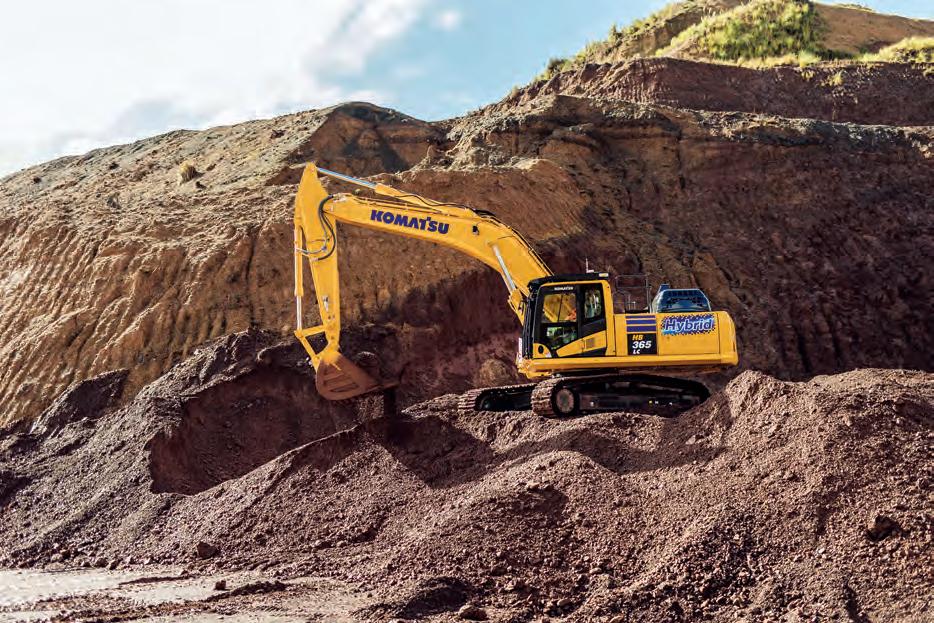
than a one-off solution, reinforcing our dedication to delivering value beyond expectations. To ensure success in bundling and packaging these solutions, attention is also directed towards training our service teams and providing them with the necessary resources.”
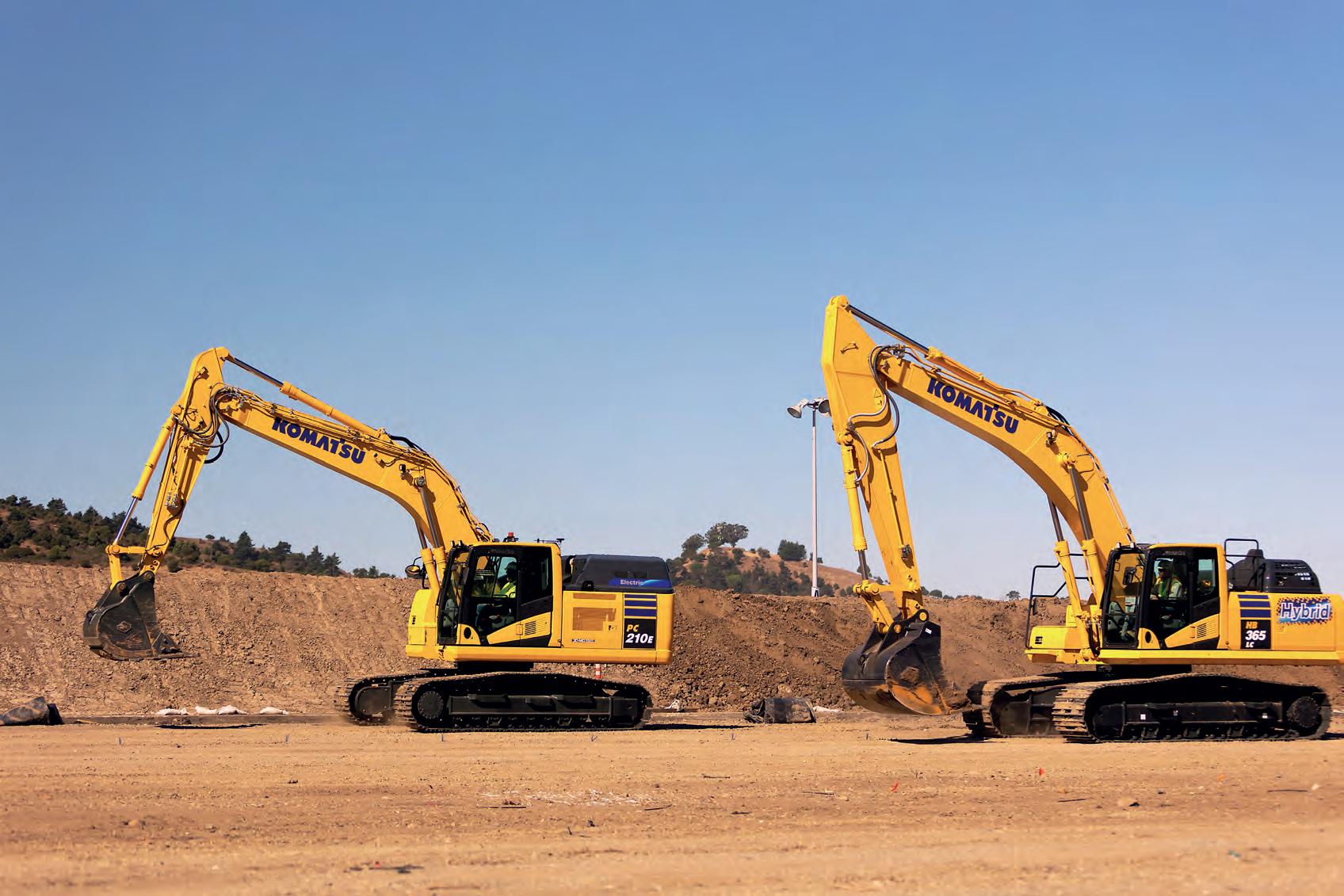
In recent years, Small says, the industry has witnessed the surging development of smart machines that enable monitoring, diagnosis, and predictive maintenance, with Komatsu at the forefront of this evolution. Although machine components may still encounter failures, these advances aim to facilitate planned interventions, minimising the impact on adjacent parts and systems.

“Additionally, we are delving into smart learning, leveraging data to predict market size and direction, while enhancing our forecasting accuracy,” says Small. “This enables us to better predict equipment needs, resource scheduling, and parts requirements.”
New challenges will come with equipment electrification, and Komatsu is diligently preparing for the changing skill sets and regulatory requirements through its training academies.
As these solutions become commercially available, there is a growing enthusiasm among people to adopt them.

Organisations are increasingly conscious of their ecological impact and footprint, prompting a search for offerings, such as electric machines, that can help minimise these effects.
“Customers in the Australian and Oceania market, including New Zealand, are early adopters of new technology,” says Small.
“We saw that with guidance control. They actively seek the latest advancements and challenge us to bring innovations forward. That’s why we are focusing on electrified solutions. We are witnessing a demand for electric solutions, and while introducing new models, commercial viability and price points are critical considerations. The market, driven by both regulatory mandates and commercial incentives, will determine the pace of adoption.”
Komatsu is trialling several batteryelectric models in Australia, including the three-tonne PC33E Electric Mini Excavator and 20-tonne PC210E Electric Hydraulic Excavator. These machines are being put to work with a select group of Australian customers, generating valuable data for Komatsu’s engineering teams. This data will be used to optimise the machines for the unique and harsh conditions of Australian applications. This marks just the beginning of Komatsu’s expanding electric portfolio.
“Since launching our first hybrid in Australia in 2008. The range caters to the unique requirements of our customer base,” says Small. “Our customers tell us that hybrid is a great steppingstone technology, a proven technology available now.”
Small anticipates a trajectory similar to the rapid advances in computer technology, foreseeing progress in
battery technology driven by substantial investments in various industries. This evolution is expected to contribute to the broader adoption of electric solutions in the equipment sector.
“Our commitment persists in striking a balance between environmental considerations and commercial viability,” says Small. “We remain mindful of the unique challenges posed by equipment electrification and are proactively working to address them.”
Over the next 12 to 18 months, Small expects to see the release of more electrified machinery by various global companies. The transition from conceptualisation to commercial availability is imminent. However, he emphasises it’s crucial to consider the skill sets required for working on electric equipment.
“Merely unwrapping the product won’t suffice; a comprehensive understanding of maintenance requirements, parts consumption and the ability to troubleshoot faults promptly is crucial,” says Small. “Assessing the availability of local skills becomes essential for a swift response to issues.”
As these advancements materialise, they will pave the way for a more defined trajectory in the evolution of electrification, shaping the industry landscape, with Komatsu leading the way.
Electrification is not the only power innovation explored by Komatsu. The company is also conducting advanced trials with its mid-range concept hydrogen fuel cell hydraulic excavator. This excavator emits only water and air while generating the energy needed for efficient operation.
“In essence, what I observe is Komatsu excelling in finding and implementing innovative ideas sourced from different corners of our global network,” says Small. “This collaborative effort ensures that we stay at the forefront of industry trends, such as electrification and smart construction, providing our customers with cutting-edge solutions and an enhanced user experience.”
As the industry witnesses the unfolding of electric, hydrogen and smart construction solutions, Komatsu stands ready to provide seamless adoption, comprehensive support and unparalleled expertise, ensuring a future where innovation meets excellence in construction and utility.
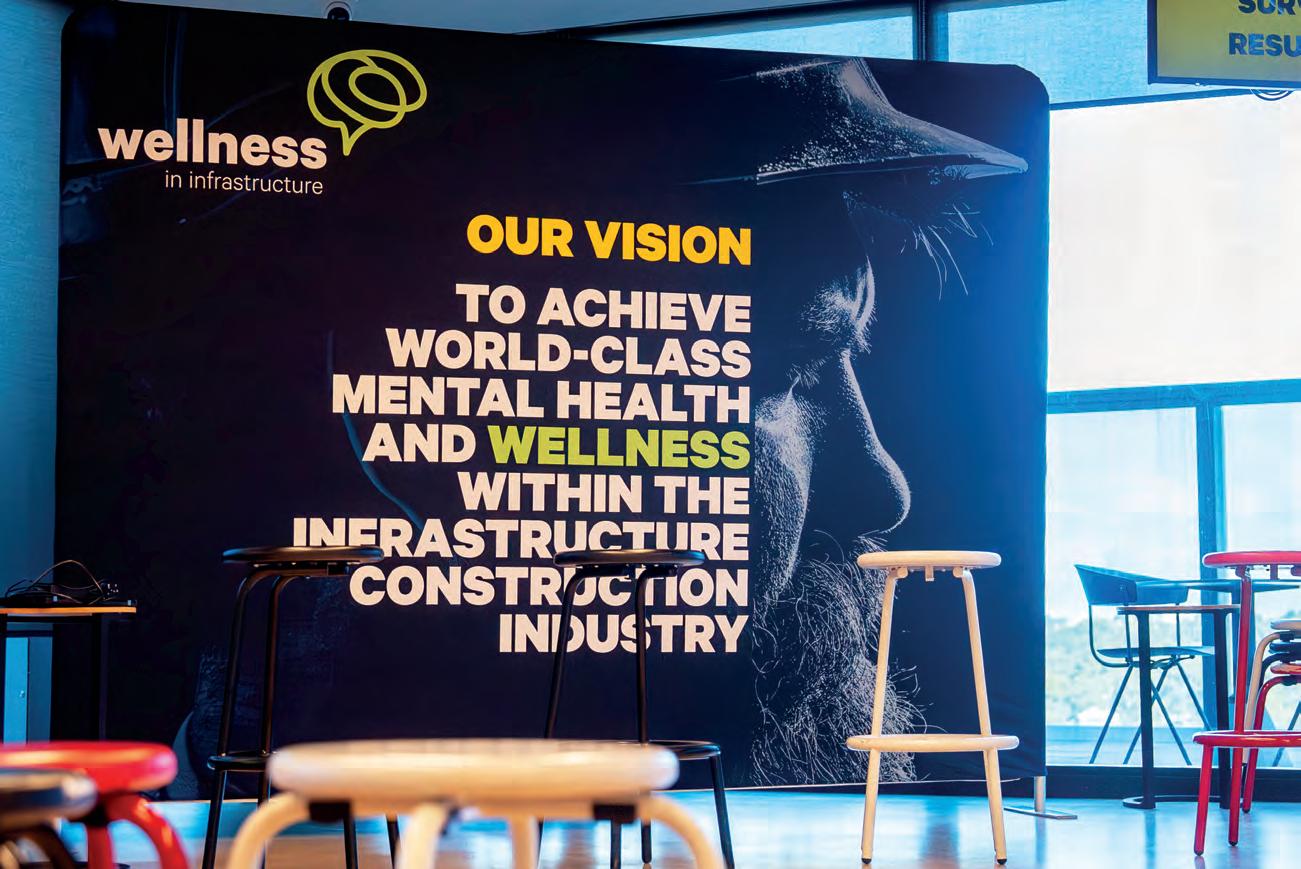
THE CASE FOR WELLNESS
ROADS & INFRASTRUCTURE MAGAZINE LEARNS MORE ABOUT ‘WELLNESS IN INFRASTRUCTURE’ AND HOW THE ENTITY IS HELPING TO FORGE AN OPTIMISTIC FUTURE AROUND MENTAL HEALTH AND WELLBEING.
The Wellness in Infrastructure (WII) initiative was developed in 2018 by a group of senior business leaders who wanted to collectively address the mental health and wellbeing challenges being encountered by professionals in the infrastructure construction industry.
The initiative was inspired by a study conducted by Professor Luke Downey from Swinburne University. This study – which incorporated feedback and insights from those in the sector – revealed that nearly half of the 683 infrastructure industry respondents suffered from burnout, while 85 per cent reported moderate to high levels of stress.
WII was formed through the collaboration of volunteers from various Tier One and Tier Two infrastructure construction companies, Victorian Government authorities, and industry associations. From its onset, the initiative aimed to address the prevalent issue of poor mental health among infrastructure industry staff and the known industry factors contributing to adverse mental health impacts for the betterment of the industry.
Up until mid-2023, WII was led by a steering committee comprised of senior business leaders within the industry. This committee was supported by a working group of industry participants who were
passionate about uniting and exchanging ideas on best practices. Since mid-2023, WII has been operating as a not for profit in Australia with a dedicated Board, Committees and base of volunteers. Together, they worked towards driving high-level change in infrastructure construction companies as a collective.
MAKING AN IMPACT
Since its formation in 2018, WII has achieved several milestones in its drive to improve mental health and wellness in the infrastructure construction industry.
As part of a 2018 Industry Survey and Report, founding members of WII conducted the largest mental health/ wellness survey in the sector, highlighting the unsustainable levels of compromised health and wellness from the respondents. A cross-section of more than 100 employees from participating companies were also involved in engagement workshops and assisted in identifying the factual causes of the current state of mental health in the industry.
Another key milestone was the establishment of the Integrated Approach to Wellness Program. This critical work demonstrated what is possible when taking a preventative approach to mental health


and wellbeing. This program has continued to be implemented across several projects and programs of work after its successful piloting on the Mordialloc Freeway Project.
The establishment of the WII mentoring program has provided a platform for passionate industry mentors and mentees to enhance their skills, contributing to the transformation of the industry and improving the management of mental health issues in the present and future.
WII, in collaboration with Downey, undertook a five-year follow-up in late 2023, which gathered more than 1411 survey responses from the industry. The results reveal that workers in the infrastructure industry remain at some of the highest risk in society for burnout, declining mental health, stress, and dissatisfaction with work-life balance despite several minor improvements in the results of the last survey conducted in 2018.
WII has a track record of developing and providing programs and tools that have been validated to improve mental health, wellbeing, and productivity. The success of these interventions can be attributed to
them being developed by, or in direction consultation with, industry professionals.
READY TO GO
The infrastructure and construction industry continues to face challenges in terms of the mental health and wellbeing of its professionals. This crisis is having a negative impact on the industry’s productivity, diversity, and overall attractiveness. Therefore, it is crucial to address the physical and psychological risks that industry professionals encounter and improve their overall health and wellbeing.
This is where WII comes in to provide verified interventions, support, and resources to safer, healthier work environments that benefit employees and employers alike. WII has demonstrated a commitment to improving the industry, and its interventions have proven effective in improving mental health and business outcomes.
Today, WII is formally established as a not-for-profit, health-promoting charitable organisation and comprises a board of experienced individuals and more than
40 volunteers from across the industry. All are working towards a single goal, which is to achieve world-class mental health and wellness within the industry across Australia. WII has reached a definitive point in its storied journey, and to continue with the initiative, it requires funding and support from the industry to deliver on the mission successfully.
Upfront contributions to WII will help to employ key personnel to promote, administer, and expand the organisation as well as develop mental health framework tools and interventions designed specifically for the infrastructure/ construction industry and to share best practice initiatives from across the industry. WII, along with its partners and supporters from across the sector, are aiming to create an industry that is more productive, rewarding, and sustainable for professionals of today and tomorrow. This is a direct investment into a brighter future for the industry.
To donate, visit: linkedin.com/company/ wellness-in-infrastructure/ or contact donations@wellnessii.com.au

Now there’s another reason to own the SAFEST SKID STEER on the market

Benefitting from JCB’s unique PowerBoom design, a single-sided reinforced high tensile strength steel boom that features 20% more steel than its competitors, JCB’s skid steer range is built to tackle tough jobs that require a compact machine with heavy duty features.
Safety is also a key priority and with exclusive left-hand-side entry operators can access the JCB skid steer without having to climb over large attachments or under an unsupported boom, and with a 270° field of vision the range offers up to 60% better visibility than rival machines.
For the ultimate in versatile performance the JCB skid steer range offers endless possibilities.
To find out more and take advantage of this great offer speak to your local JCB CEA dealer today!
Ph: 1300 522 232
www.jcbcea.com.au


SUSTAINABLE SILENCE
SOME INSIGHT INTO THE FACTORS AND KEY REASONS FOR THE RISE OF HOLLOWCORE PRECAST CONCRETE NOISE WALLS THROUGHOUT AUSTRALIA.
In sprawling suburbs where urban life meets tranquil residences, the challenge of managing noise pollution has prompted an innovative solution: hollowcore precast concrete noise walls. One of the many projects employing this technology is the standout Metronet Thornlie-Cockburn Link project in Western Australia, where Atlas Precast, a National Precast Master Precaster, is pioneering the use of terracottacoloured hollowcore noise walls. These walls represent a significant advancement in sustainable and durable infrastructure solutions, reflecting a growing trend toward environmentally responsible construction practices.
The hollowcore design of these concrete planks offers numerous environmental benefits over traditional concrete and alternative material options. By optimising the use of materials, the planks save about 20 per cent in cement and reduce the weight of steel by 80 per cent. Such material efficiency translates into a remarkable reduction in carbon emissions – specifically, a cradle-to-gate carbon saving of 63,104 kilograms CO2e. To put it into perspective, this is akin to the emissions saved from nearly 14 petrol cars driven for a year. This substantial decrease in environmental impact demonstrates the potential of advanced construction materials to contribute to a more sustainable future.
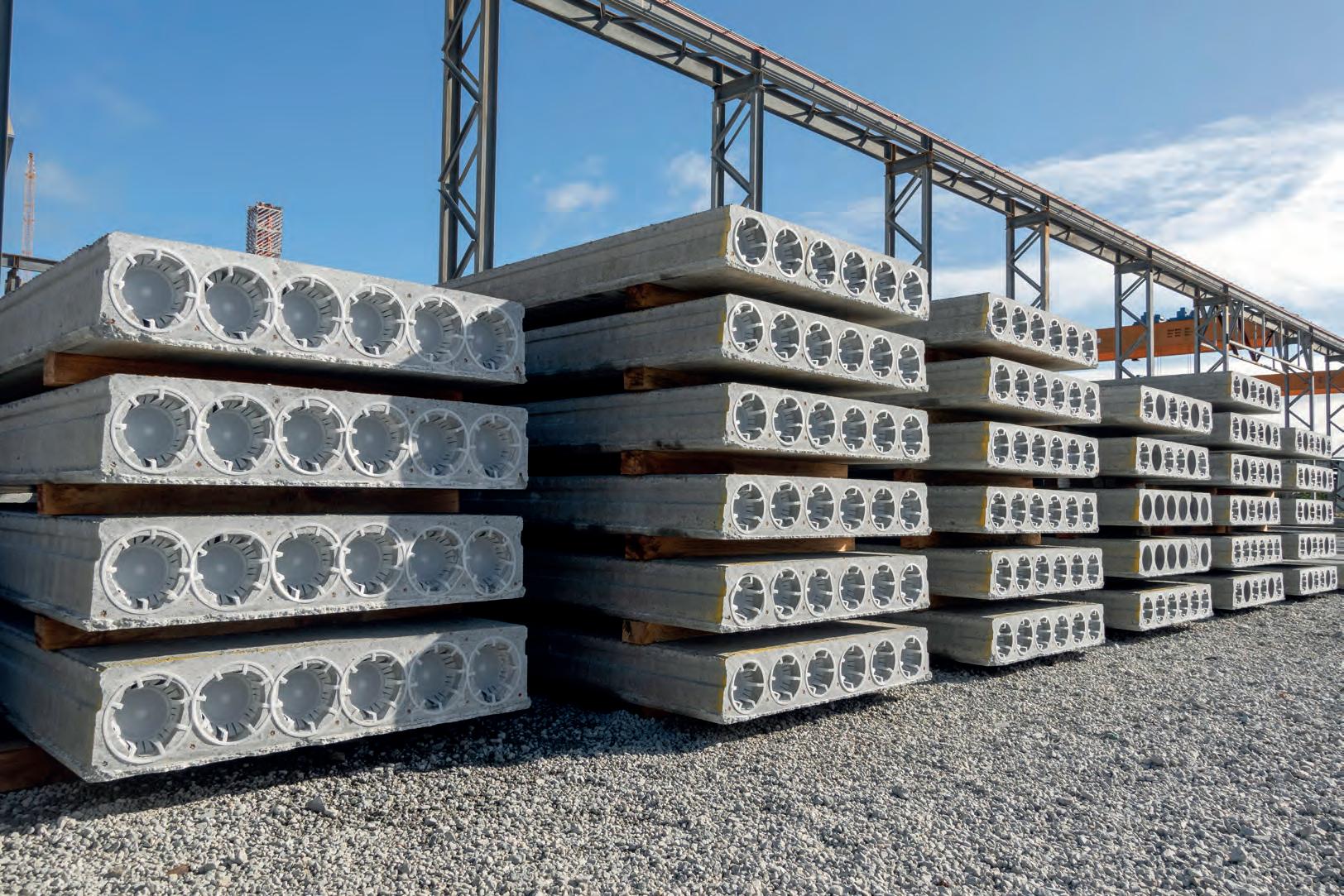
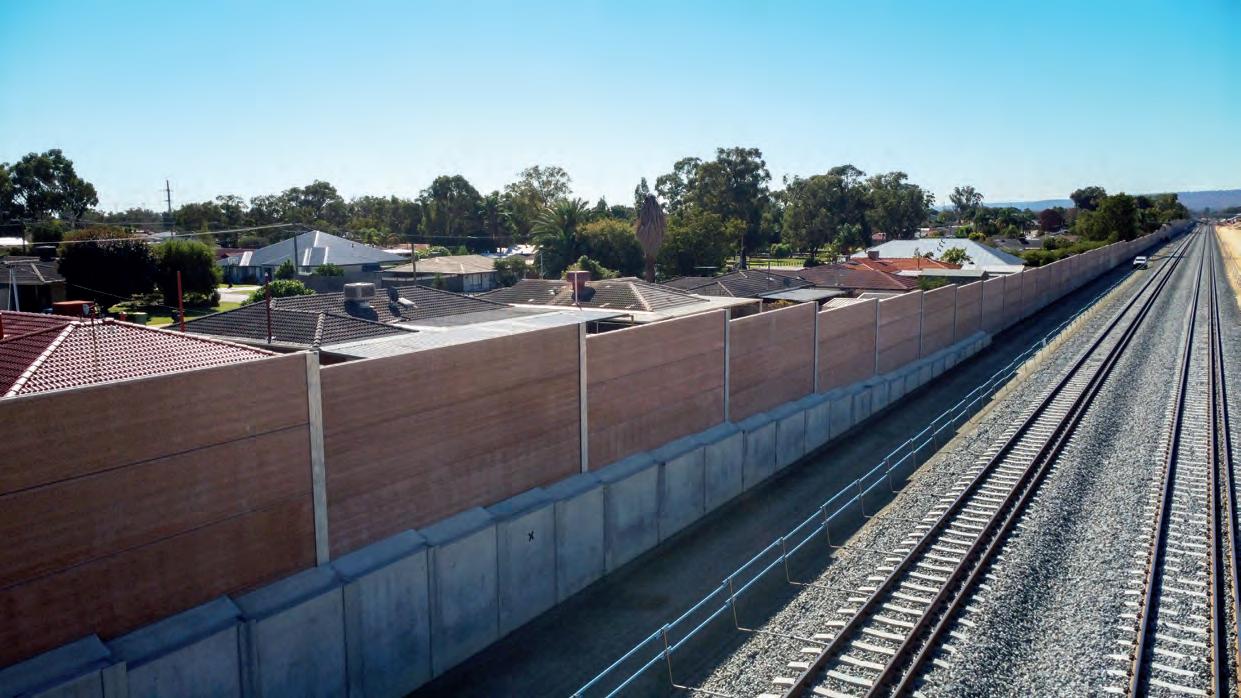
Conventional noise wall designs are being thrown out the window in favour of more sustainable and durable hollowcore noise walls.


“PRECAST CONCRETE DOES NOT SUCCUMB TO ROT, RUST, CORROSION, TERMITES OR FIRE AND IT REQUIRES MINIMAL MAINTENANCE OVER ITS INCREDIBLY LONG LIFESPAN, MAKING IT A COST-EFFECTIVE SOLUTION IN THE LONG TERM.”
But the benefits of hollowcore precast concrete walls extend beyond their green credentials. These walls are engineered for durability and longevity, designed to withstand the harsh elements while providing effective noise mitigation. In the context of the Metronet project, these attributes are crucial.
The installation spans almost nine kilometres of rail corridor, with wall heights varying between 2.4 to 5.5 metres based on proximity to residential areas, existing barriers, topography and anticipated noise levels. The choice of hollowcore walls ensures that these variables are addressed with a tailored, effective solution that maintains aesthetic appeal through its distinctive terracotta hue.
Engagement with the community was a cornerstone of the project’s planning phase. Residents’ concerns about
noise and the visual impact of the new infrastructure were met with responsive design and thoughtful implementation.
The use of terracotta-coloured walls, in particular, demonstrates a commitment to not only functionality but also to aesthetic integration into the local environment. This careful consideration likely played a significant role in minimising project impacts and maximising satisfaction among property owners and tenants affected by the construction.
Installation of these noise walls is carried out in stages, allowing for gradual integration into the community and less disruption to daily life.
This phased approach also enables adjustments based on ongoing feedback and environmental monitoring, ensuring that the project’s execution aligns with its intended goals.
In comparison to other materials typically used for noise barriers, such as steel or timber, hollowcore precast concrete offers superior noise reduction capabilities. Its mass and density effectively block and absorb sound, protecting communities from the intrusive noise associated with rail and road traffic.
Additionally, unlike timber or steel, precast concrete does not succumb to rot, rust, or corrosion, and it requires minimal maintenance over its lifespan, making it a cost-effective solution in the long term.
The Metronet Thornlie-Cockburn Link project exemplifies how innovative construction materials like hollowcore precast concrete can transform a necessary public utility feature into a sustainable, community-focused solution. As cities continue to expand and seek new ways to mitigate environmental impacts, the role of advanced materials like hollowcore precast concrete in urban infrastructure is set to increase, marking a new era of sustainable development in public works.
POSITIVE OUTCOMES FOR THE SUPPLY CHAIN SUPPLYING
WITH LOGISTICS INCREASINGLY STRAINED BY ECONOMIC AND GEOPOLITICAL CHANGES, MEGATRANS IS SEEKING TO DEVELOP A SUSTAINABLE SUPPLY CHAIN FOR THE FUTURE. HAVE YOU BOOKED YOUR TICKET?
for like-minded suppliers and industry leaders to connect and discuss the role of sustainability in the supply chain and how they will be a part of the solution. From decarbonisation to a diverse workforce, the event will examine every connection in the chain.

Tmovement. From the raw materials that fuel industries to the finished goods that fill shelves, a complex web of logistics keeps the supply chain humming. But in today’s ever-evolving global landscape, challenges are everywhere. Disruptions, delays, and rising costs threaten to snarl this critical system of efficiency.
It will take the most advanced technology, ground-breaking initiatives, forward-thinking companies, and talent to create a truly sustainable supply chain
represents a fantastic
that industry leaders can be proud to pass on to the next generation.
MEGATRANS seeks to bring leaders from across the supply chain together in Melbourne to discuss the future of the logistics industry and its critical role within the economy.
It is an interactive expo reserved for companies offering advanced technologies and services grouped by their contributions to the sustainable supply chain.
The combined conference, exhibition, and jobs pavilion will be an opportunity
The exhibition will focus on some critical areas of the industry, including: fleets of the future, the zero-carbon warehouse, the traceable supply chain and cold chain solutions.
Experts from across Australia will gather to discuss the issues that are shaping the future of the sustainable supply chain, including workplace diversity.
Retailers, manufacturers and warehouse managers will share their success stories of building a diverse workforce.
In addition, traceability can ensure the sustainability of a supply chain, particularly one built on ethical practices and suppliers every step of the way.
The ethical supply chain stream will include presentations from major retailers who will outline their plans for the future of ethical sourcing.
An additional challenge is finding the real estate to grow the logistics industry. This stream will involve discussions with representatives from industrial parks, warehouses, and real estate companies about the future of facilities planning.
MEGATRANS will also host the inaugural Sustainable Warehouse Competition. In an era where sustainability is not just a buzzword but a vital component of operational strategy, MEGATRANS wants to spotlight the pioneers of warehouse sustainability. The Sustainable Warehouse Competition aims to celebrate and promote the ground-breaking efforts of warehouses nationwide that are dramatically reducing their emissions and implementing sustainable practices.
For more information, visit: https:// megatrans.com.au/
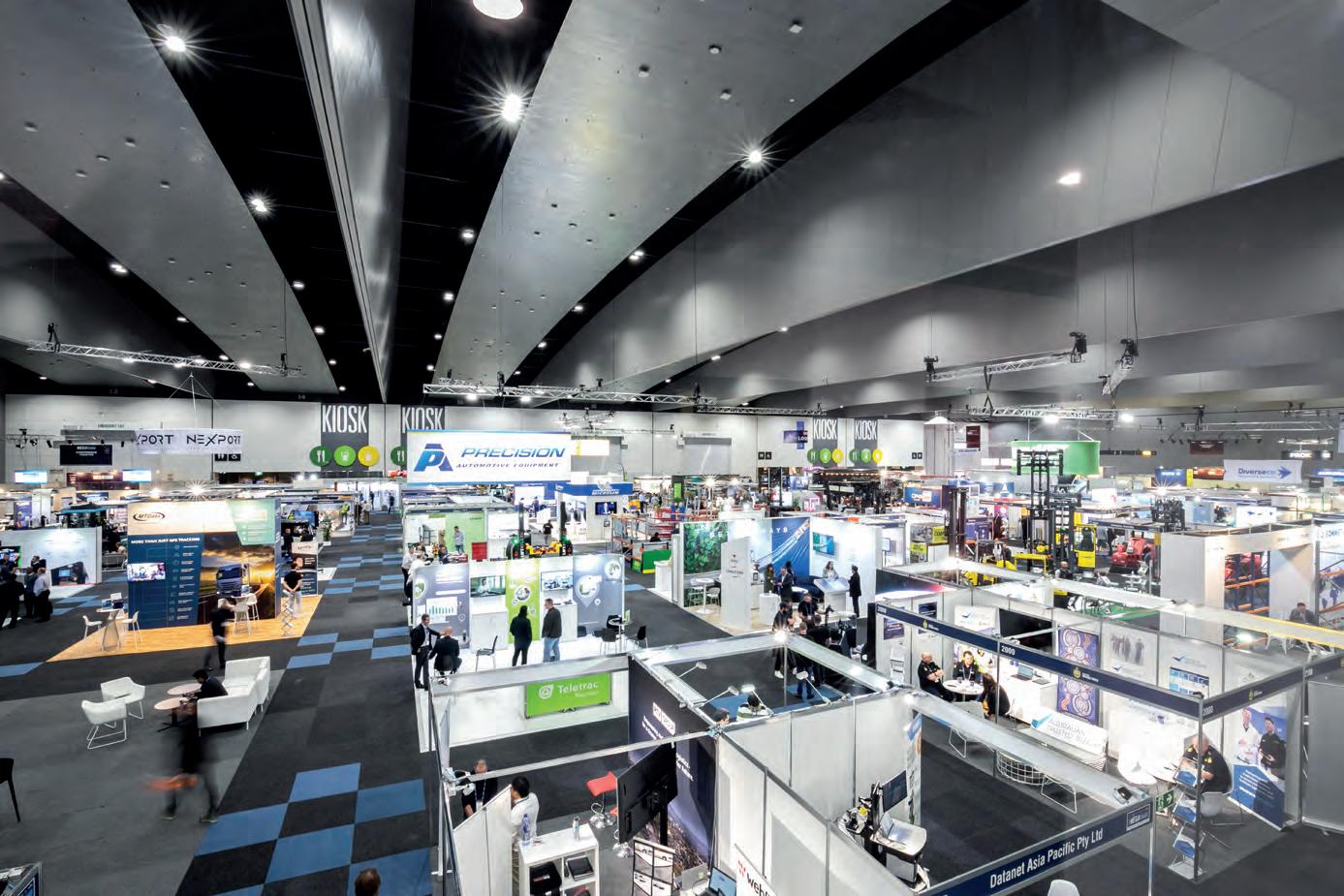

BULKING UP FOR A MAJOR EVENT
BULK2024 IS AUSTRALIA’S ONLY DEDICATED EXHIBITION FOR THE BULK SOLIDS HANDLING INDUSTRY. ARE YOU GOING TO BE IN MELBOURNE ON 18-19 SEPTEMBER FOR BULK2024?
The bulk handling industry has long been a cornerstone of the local economy and is critical to global security. The Australian Bulk Handling Expo (BULK) will return to Melbourne in September 2024, connecting people to people and business to business while showcasing solutions that will help the industry move products to where they are needed most – domestically and internationally.
With the bulk handling industry facing skills shortages and an ageing workforce, securing its future is critical to the continuation of Australia’s economic growth. Technological advancement and automation will have wide-ranging impacts on the industry. Understanding these impacts will be a significant focus of BULK2024.
The event will feature an expansive trade show showcasing the latest solutions for the industry and host an informative two-day conference where discussions will focus on how businesses can take the next step to remain cuttingedge in a constantly changing world.
BULK2024 will bring together leading companies from right across the bulk solids handling sector to connect and
examine the role that technologies will play, how to use them to their advantage and what else can be done to further improve efficiencies. The exhibition is exclusive to companies offering innovative solutions for the industry.
The Australian Society for Bulk Solids Handling (ASBSH) is the industry body that supports BULK2024. As a technical society from Engineers Australia (EA), it aims to promote co-operation between universities, researchers, consultants, equipment manufacturers, suppliers, and industrial users of bulk solids. ASBSH also seeks to encourage research and development, technology transfer and training. It holds regular national and international conferences while promoting undergraduate and further postgraduate education in bulk solids handling.
AUSTRALIAN BULK HANDLING AWARDS
One of the highlights of BULK2024 will be The Australian Bulk Handling Awards – the only awards program specifically for the bulk solids handling industry. The awards are an opportunity to acknowledge and celebrate the outstanding achievements of companies
and individuals who have demonstrated innovative practices and superior performances across the year.
In 2024, the Australian Bulk Handling Awards will be held alongside the Mercury Awards, which recognise excellence in the logistics sector.
A joint gala evening will feature both sets of awards, providing increased brand visibility and larger attendance for the evening.
There are several awards to be handed out at the Bulk Handling Awards and the Mercury Awards. They are:
• Innovative Technology
• D ust Control Technology, Application or Practice (proudly sponsored by Kinder Australia)
• E xcellence in the Application of Gears, Motors or Drives
• E xcellence in Transport and/or Conveying
• B est Practice in Safety
• S upplier of the Year
• B ulk Handling Facility of the Year
• AW Roberts Award
• T he Australian Society for Bulk Solids Handling Award
For more information, visit https:// www.bulkhandlingexpo.com.au/
THE GATEWAY TO OPPORTUNITY WA MINING:
THE 2024 WA MINING CONFERENCE AND EXHIBITION WILL PROVIDE A PLATFORM FOR THE INFRASTRUCTURE INDUSTRY TO CONNECT, NETWORK, AND LEARN.
According to Western Australia’s Department of Jobs, Tourism, Science and Innovation, the mining industry represents about 45 per cent of Western Australia’s gross state product (GSP). Western Australia’s (WA) mining industry achieved another record level of employment with an average of 130,165 full-time-equivalents (FTEs) in 2023, reflecting strong levels of mining and construction activity in the state.
The 2024 WA Mining Conference and Exhibition is a prime opportunity to present technical, technological, and digital advancements throughout the entire mining value chain.
It vividly demonstrates Western Australia’s economic significance, its ability to innovate, create jobs, and attract capital.
It allows METS (Mining equipment, technology and services) suppliers and other infrastructure providers to engage with a quality audience of mining industry professionals.
This event will provide the ultimate platform to showcase the latest range of products or services, access new sectors or regions and place attendees in front of Western Australia’s mining industry.
Rio Tinto will be represented by the keynote speaker for the 2024 WA Mining Conference and Exhibition.
Other key players in the industry will be in attendance, with previous key decision-makers from Alcoa, BHP, Fortescue, South32 and Roy Hill representing just a few of the potential attendees.
WA Mining will feature a highly targeted, paid-to-attend conference covering key themes such as critical minerals, industry outlook, and digital and autonomous systems.
Hear from mining decision-makers, technology experts, and industry leaders sharing their perspectives on the future opportunities that will drive
growth and sustainability for the sector. Engage with a high-quality audience of mining industry professionals looking to evolve, adapt and improve their mining operations. Developed purely for the Western Australian market, WA Mining provides you with the opportunity to grow your business in this expanding region.
It will provide engineers, mine managers, site superintendents, HSE managers, exploration managers, and operations managers with the technological insights that will shape the future of the mining industry.
Digital experts know that digitalisation and automation are pushing the industry into new frontiers.
The WA Mining Conference will examine these new technologies and applications and draw insights from digital experts across a variety of sectors
WA Mining Conference will feature over 100 displays of equipment and stands.
that could have applications in mining. Cyber security managers, technology heads, and chief technology officers will be in attendance as they look to discover the technological step-change.
With sustainability and innovation remaining at the forefront of the community’s relationship with the sector, industry and stakeholder engagement are paramount to the mining industry’s success.
WA Mining Conference will look at the social license to operate and the most effective way to limit the environmental impact of mining in Western Australia. Environmental managers, as well as stakeholder and community engagement managers, will hear from industry and government experts.
Limited exhibition spots remain. To find out more, visit: https://www. w aminingexpo.com.au/
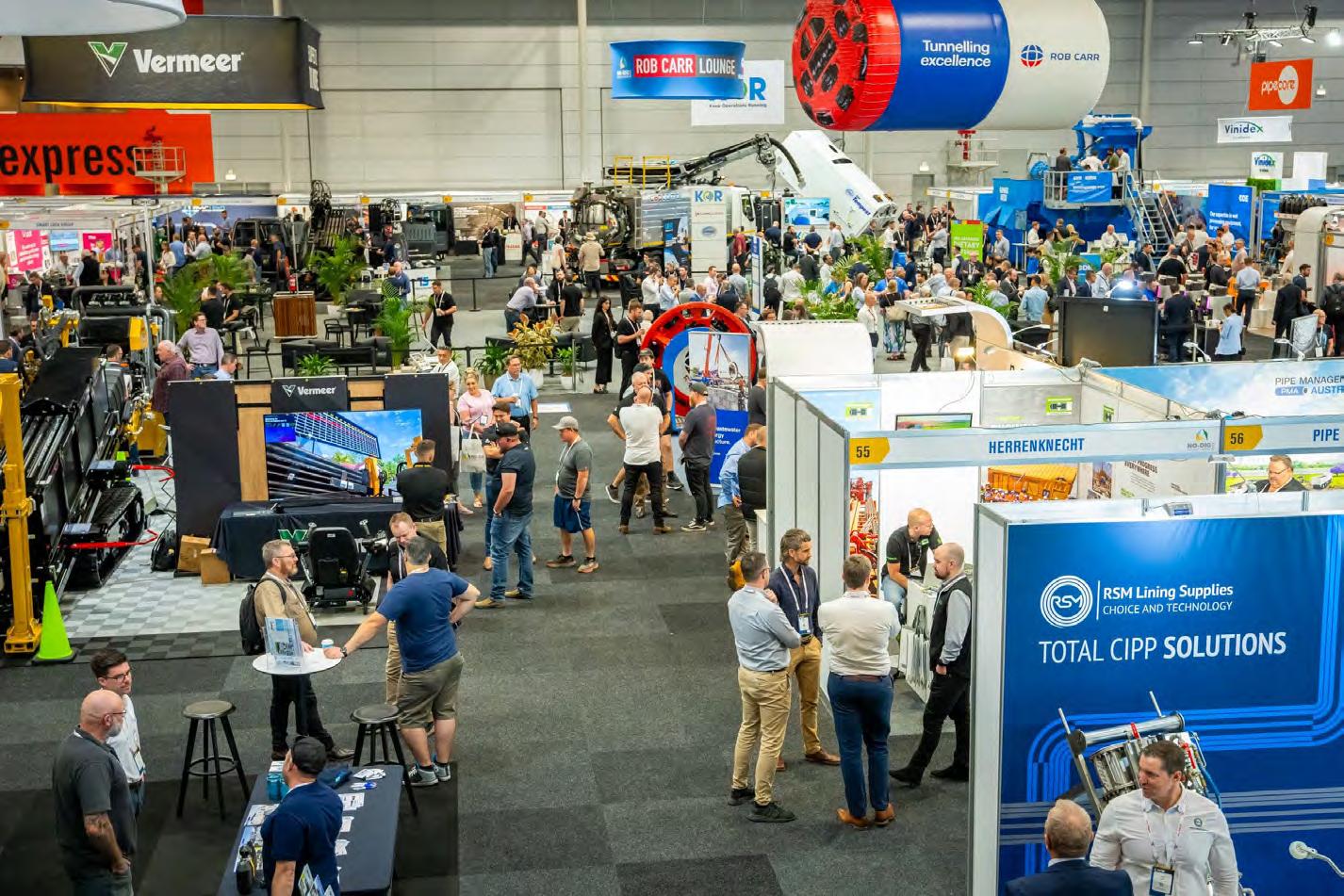


TRENCHLESS TECHNOLOGY ONE STOP-SHOP FOR
THE 2025 NO DIG DOWN UNDER CONFERENCE, THE LARGEST TECHNOLOGY EVENT IN THE SOUTHERN HEMISPHERE, WILL PROVIDE THE SECTOR WITH MODERN SOLUTIONS TO TACKLE ISSUES ASSOCIATED WITH MAJOR INFRASTRUCTURE
No-Dig Down Under is the southern hemisphere’s only large-scale conference and exhibition dedicated to trenchless technology and it’s set to come back even bigger and better in 2025.
Trenchless technology is important for installing new services, as well as rehabilitating and maintaining existing pipelines and infrastructure, without having to dig multiple trenches, disturbing traffic, business and residential locations.
With major utilities located underground and requiring ongoing upkeep and extension, No-Dig Down Under is a crucial event for local government representatives and those involved in planning decisions for major infrastructure projects.
The No-Dig conference promises to bring attendees the very latest information about products designed to make trenchless installation and rehabilitation easier and more efficient.
A range of training courses on trenchless methods will be presented
prior to the conference and will be led by industry leaders from Australia and overseas, providing value to anyone who encounters trenchless technologies as part of their roles.
The technical program invites speakers from around Australia and the globe to present papers covering case studies, new and emerging technologies, challenging projects and environments, industry skills and training, risk management and more.
The training courses and technical program are supported by an exhibition hall extending over 4500 square metres, featuring exhibitors from all sectors of the industry. Finally, three sponsored social functions will be held, including the prestigious Australasian Society for Trenchless Technology (ASTT) Gala Dinner and Awards Evening, providing attendees with networking opportunities in a variety of settings with industry professionals.
Organised in partnership with the ASTT, No-Dig Down Under has grown over the years to become the second largest no-
WORKS.
dig technology event in the world and is now considered a ‘must-attend’ for all industry professionals.
The ASTT is the peak body for trenchless technology in Australasia, providing advocacy, leadership, support and educational opportunities for organisations and individuals involved in trenchless technology.
For 30 years, the ASTT has provided members with access to the latest technological advancements, technical information, and educational opportunities through Trenchless Australasia magazine, the No-Dig Down Under conference, as well as providing access to industry tools, technical forums and webinars.
Gold sponsors have already been announced, with Pipe Core, Rob Carr and Vermeer Australia leading the way.
Now you have the opportunity to sponsor or exhibit at the event, which is set to be the largest yet.
To find out more about the upcoming NDDU Conference, visit: nodigdownunder.com
CONTRACTS IN BRIEF
ROADS & INFRASTRUCTURE PROVIDES AN UPDATE ON SOME OF THE CONTRACTS AND TENDERS RECENTLY AWARDED OR PUT TO MARKET ACROSS THE AUSTRALIAN INFRASTRUCTURE SECTOR.
VICTORIA
Contract awarded for Melbourne Airport works
A contract has been awarded to Seymour Whyte by Australia Pacific Airports for works on the Melbourne Airport’s Naarm Way Stage Two, which will reduce traffic congestion and enhance safety to new dedicated pick-up and drop-off zones. Naarm Way Stage Two will provide a direct connection from the Tullamarine Freeway to new dedicated pick-up and drop-off zones in the T123 car park. The two-stage project will create a more streamlined exit from the Tullamarine Freeway to all four terminals, meaning travellers will no longer need to navigate roundabouts or traffic lights to access the pick-up and drop-off zones and parking areas. The project’s design focuses on separating public traffic, pedestrians, and commercial transport operators through an elevated road network. This initiative streamlines traffic flow from the Tullamarine Freeway to all airport terminals, facilitating a smoother and more accessible journey for all airport users. As part of the project, a new pedestrian bridge will provide direct passenger access from the T123 parking structure to Terminal Two. Construction has started, with completion in 2026 aimed to significantly improve operational efficiency and passenger satisfaction. Seymour Whyte completed Melbourne Airport’s Naarm Way Stage One works connecting the Tullamarine Freeway directly to Terminal Four in July 2023.
WESTERN AUSTRALIA
Major contracts awarded for Lumsden Point project
Pilbara Ports has awarded two major contracts for works on Western Australia’s Lumsden Point, in the port of Port Hedland. Lumsden Point will facilitate the export of battery metals such as lithium and copper concentrates, the import of renewable energy infrastructure including wind turbines and blades, as well as support the growth of direct shipping services to the Pilbara. The first major contract is to Jan De Nul (Australia) Pty Ltd for dredging and land reclamation.
This contract will create a new access channel in the port to enable vessels to safely berth at Lumsden Point, a swing basin and berth pockets suitable to accommodate non-tidally restricted vessels. Jan De Nul will mobilise to site in May 2024 to prepare for dredging, which is expected to begin September 2024. The second contract is to MGN Civil Pty Ltd for the construction of the causeway, which will connect the new wharf to the proposed logistics hub area. Construction started in April. The Federal Government is investing $565 million in common user port upgrades in the Pilbara, $450 million of which will enable the development of new multiuser facilities and berths at Lumsden Point. This is in partnership with the Western Australian Government, which is contributing $96.6 million to the project.
NEW SOUTH WALES
Preferred contractor announced for Sydney Metro contract
A Joint Venture has been awarded a contract to deliver the final package of works to convert the almost 130-yearold T3 Bankstown Line to modern metro standards for Sydney Metro. The Joint Venture comprising of John Holland and Laing O’Rourke will undertake works across a 13-kilometre alignment from Marrickville to Bankstown. This package of works consists of significant upgrades at Bankstown and the construction of a new metro station, as well as modifying and building new infrastructure and systems to allow for continued Sydney Trains operations at Bankstown Station when metro services commence. It will also include completion works to convert nine stations to metro standards including the installation of wayfinding and upgrades to station buildings and structures. Additional works will include completion of overhead wiring and final track alignment work. In other news, major works are being undertaken to construct the new metro platforms at Bankstown, having installed the structural steel and precast panels, and completing a concrete pour
crucial to the platform’s overall structure. These works mark some of the major preparations needed before the final 12-month shutdown of the line starting later this year, set to take place after the launch of City metro services between Chatswood and Sydenham.
QUEENSLAND
Companies invited to tender for $95M Mount Lindesay Highway
Tenders have been released to market for works on the $95 million Mount Lindesay Highway in Queensland, with the detailed design for the new south-bound bridge now finalised. Tenders for the construction of upgrade works on the Mount Lindesay Highway between Johanna Street and South Street in Jimboomba will deliver safety improvements, ease congestion, and reduce travel times by widening the highway from two to four lanes, including construction of a new south-bound bridge over the disused rail corridor. The construction tender process will take approximately three months and major construction is expected to start in late 2024 and expected to take approximately 18 months to complete. A construction tender was released to market in early 2023 but then withdrawn pending the outcome of the Australian Government Infrastructure Investment Program Review. Early works on the project were completed in 2023. The Department of Transport and Main Roads (TMR) has a 10-year forward plan (2018-2028) for the Mount Lindesay Highway, with construction projects being delivered as funding becomes available. Pedestrian and bike riders will also benefit with new active transport shared paths being installed and upgraded across the project scope.

ATLAS COPCO
HILIGHT BI+4 LIGHTING TOWER






The
and
